Former Colombian Pres. Starts Controversy at BC
LABC extended the speaker invitation.
BY ERIN SHANNON Copy Chief BY MEGAN KELLY News Editor

The Latin American Business Club of Boston College (LABC) has come under fire after hosting Álvaro Uribe—the former president of Colombia who has been accused of human rights violations, witness tampering, and corruption—to give a talk on the political landscape in Latin America last Monday.
“My purpose was to create confidence in Colombia … with three elements: security … but with the rule of the law … ,with democratic values and freedoms, in contrast with what was known as a policy of national security in many Latin American dictatorships,” Uribe said at the event.
Uribe is a controversial figure in Co-
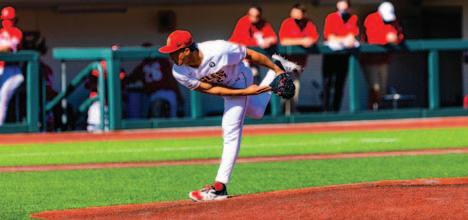
lombia because of the killing of thousands of citizens by the Colombian army during his presidency, which is still being investigated by the United Nations.
He was also arrested in August last year on charges of witness tampering, bribery, and crimes against humanity for an alleged involvement with right-wing death squads.
He was released from house arrest in October of last year. Despite these recent charges, he left the office of the president in 2010 with high approval ratings due to his handling of Colombian guerrilla groups.
Under Uribe, the Colombian military drove the Revolutionary Armed Forces of Colombia (FARC) out of Colombia’s cities and towns. He also drastically reduced the FARC and National Liberation Army’s numbers during his tenure in office. Uribe received the Presidential Medal of Freedom from the United States in 2009 for these initiatives and for reducing violence throughout Colombia.
Bring Out the Brooms

4C Honors Local COVID-19 Victims
The project will be planting five trees on BC’s campus.
BY JULIA REMICK Metro Edtitor





To commemorate the lives lost to COVID-19 in Newton, Green Newton’s Environmental Youth Leadership Program is planting 170 trees throughout Newton and five trees on Boston College’s campus.


The project is called 4C Tree Project, which stands for capture, carbon, commemorate, and COVID-19. It was spearheaded in October by Elizabeth Sockwell, an alumna of Newton South High School and current senior at Trinity College.
“The project is basically trying to plant one tree, approximately, for every person who has passed away from COVID-19 in Newton,” Jojo Parks, who helped organize the project and CSON
’24, said.
Planting the trees will serve as a lasting memorial for the 214 people that have died from COVID-19 in Newton as of Wednesday.
“COVID-19 has impacted so many communities, but I mean Newton is our community, and it’s really taken a toll on a lot of the people here,” Parks said. “So I really thought it was a great way to create a lasting memorial and a living memorial that also beautifies our community.”
After coming to BC from New Jersey as a freshman, Parks said she wanted to get involved in local activism. The mission and values of Green Newton resonated with her, and she said she joined the Youth Leadership Program because she felt it would be meaningful.
The decision to plant trees has both practical and symbolic significance, according to Green Newton’s website.
Trees provide clean air and shade, attract wildlife, and contribute to a clean water supply, all while beautifying the
city, according to Green Newton’s website. Trees also serve as a symbol of life and strength, which Green Newton said it hopes will remind the community of the preciousness of life and the environment.
“They’ll also help prevent noise and pollution in some of the spots where they’re going to be planted. And they’re also going to create a great sense of place,” Newton’s Director of Urban Forestry Marc Welch said. “It’s going to define the location and over time that will make for a great improvement to the landscape.”
Both BC and the City of Newton are assisting the group in the process of planting the trees. Welch’s staff is assisting in planting and maintaining the trees and Gina Bellavia, director of Landscape Planning and Services at BC, will be doing the same for the trees at the University. BC will also be covering the costs of the five trees planted on its campus, according to Bellavia.
Cultural Clubs Come Together at World Fair
“It’s not just one cultural organization putting on one event and only having people from that team come,” said Jariwala. “I think [it’s] giving them a platform to all be together [and] all kind of showcases different things.”
B Y V ICTOR S TEFANESCU Asst. News Editor

Joseph Tribuiani, the AHANA+ Representative of the Hellenic Society of Boston College, manned a table cluttered with Greek flags and blue and white stickers at the Campus Activities Board’s (CAB) World Fair on Saturday afternoon. Like other club leaders at the fair, Tribuiani, MCAS ’21, said it helped students learn from his organization’s culture.
“I just hope that everybody comes to see, you know, the passion that this club provides and really the acceptance that everyone can be a little bit Greek sometimes,” he said.
CAB hosted the “World Fair” on all three academic quads, where 20 cultural clubs showed off traditions, played games, and blasted music while giving away shirts, pins, and stickers.
Resham Jariwala, CAB’s assistant director of campus engagement and CSOM ’22, said the fair gives BC’s different culture clubs the opportunity to learn from each other.
Dawin Ye, secretary of the BC Taiwanese Cultural Organization and MCAS ’23, watched as visitors of his club’s table struggled to learn a version of Mahjong that even he said he found confusing.
“I think they’re playing by traditional rules because … this is nothing like I played it before,” said Ye.
Ye said he hoped the World Fair would be a good way for students to be introduced to the organization.
“Hopefully they see that we’re like a welcoming community and that they come back for more events next year,” he said.
The weather presented issues for the outdoor event, as CAB decided to delay the fair’s opening by an hour, from 1 p.m. to 2 p.m., due to a drizzle left over from Friday’s surprise snowstorm.
The delay, though, proved to be a smart move, as rays of sunshine began to project on the quads right as the fair opened.
A12 INDEX Vol. CII, No. 9 © 2021, The Heights, Inc. www.bcheights.com
METRO: Huntington Theatre After more than one year with no shows, Huntington Theatre opens its doors.......
A10 ARTS: Arts Fest
Seniors and parents petition the University to reverse its position on guests at Commencement.
BC ON BROADWAY INSIDE THIS ISSUE NEWS...................... SPORTS................... OPINIONS................... MAGAZINE............. METRO................... ARTS....................... A2 A4 A6 A8 A9 A11
Monday, April 19,
2021
JESS RIVILIS / HEIGHTS SENIOR STAFF
See World Fair, A2
The event featured music, food, and games.
SPORTS
EAGLES BEAT FSU
A4
After losing five games in a row, BC baseball finally clinches a win against the Seminoles.
See Tree Project, A9
See
MAGAZINE
graduates
the
the
A8
Honoring two classes of seniors, No. 5 BC dominated the field on Senior Day, taking down No. 4 Notre Dame 18-12 to sweep the weekend.
Uribe, A2 ALUMNI ON STAGE
Three BC
navigated
unpredictability of
theatre industry.
a
that will feature in-person and virtual
Parents, Students React to BC Decision See Graduation, A3
HOPKINS / HEIGHTS ARCHIVES
VICTOR STEFANESCU / HEIGHTS EDITOR
Arts Council creates
hybrid arts festival
events......
JULIA
BRIEFS
Professor Starts Podcast
Peter Krause, an associate professor of political science at Boston College and author of Stories from the Field: A Guide to Navigating Fieldwork in Political Science, created a 13-episode companion podcast for his book alongside its co-editor and Clark University professor Ora Szekely, according to a University release.
“I worked on the podcast production with my research team of students, who helped plan, produce, and edit the episodes,” Krause said in the release. “Field research, regardless of where and how it is conducted, poses numerous ethical and logistical challenges, which the podcasts are designed to help the listener navigate.”
After an introductory episode released in January that discussed the findings of the book, the sequential episodes released on Tuesdays consist of 10- to 15-minute interviews with guests followed by 20- to 30-minute roundtable discussions, according to the release.
The podcast talks about methods and experiences of field research, according to Krause.
“We have scholars discussing their field experiments, surveys, archival research, policy work, and ethnology of all kinds, across a broad geography, including studies conducted in Africa, South Asia, South America, China, the Middle East, and in the United States,” he said in the release.
The final three episodes of the podcast, which will conclude this month, discuss teaching and learning fieldwork methods, Krause said.
The 12th episode features interviews with both graduate and undergraduate students who had learned from Stories from the Field, according to the release. The students reflected on how the book restructures their mindset about learning through Krause’s Research Methods in Political Science class.
“Most people perceive [the class] as dry, but it was way more useful than I definitely ever anticipated,” said Leah Hickert, MCAS ’21, in the release.
OID To Host Summit
The Office for Institutional Diversity (OID) will be hosting the sixth annual Diversity and Inclusion Summit, called “Catalysts for Change,” virtually on May 26, according to a University release.
According to the OID website, the summit is a full-day conference for Boston College faculty and staff that typically features a keynote speaker address, a panel of speakers, and individual break-out sessions.
BC Law Dean Vincent Rougeau and Vice President for Institutional Research and Planning Mara Hermano will deliver keynote speeches at this year’s summit, according to the University release.
“Over this past year, the confluence of twin pandemics, global COVID-19 and systemic racism, has served to remind us of the work that still needs to be done individually and organizationally,” OID Executive Director Patricia Lowe said in the release.
Boston College faculty and staff will have the chance to learn about promoting and maintaining inclusive environments as well as personal and organizational strategies for change, according to the release.
“As catalysts for change, we are committed to promoting and sustaining an inclusive environment that motivates us to be fully engaged in our community, enabling us to bring our whole selves in contributing to a just and equitable Boston College community,” Lowe said in the release.
Registration for faculty and staff began April 5, according to the release.
CAB World Fair Features BC Cultural Clubs
World Fair, from A1
“I was very overwhelmed this morning, given the weather, especially given the crazy snowstorm yesterday— April man, literally,” Jariwala said. “So I'm really excited. I think all the clubs are really excited as well.”
Even though the weather may not have been ideal, Scott Hsu, copresident of the Phillipine Society of BC and MCAS ’21, said he was just glad the event could still happen in person.
“You know, there's still snow like around the quads,” said Hsu. “It's not like the best weather, but at least we're able to have something outdoors, you know, it's definitely better than not having anything else.”
Hsu said it was good for members of his club to gather at the fair, as many of their experiences have been virtual this year.
“Honestly just some kind of inperson experience, you know, being able to kind of see the familiar faces that ran the club that year and like, just because we've known each other for, you know, so long,” Hsu said.
Similar to Hsu, Giovanna Befeler, secretary of the Cuban-American Student Association and MCAS ’24, said the fair being in person offered
an opportunity for interaction.
“It's nice that it was in person so people can actually see us and how we have a presence on campus and be able to speak to more people,” said Befeler.
Befeler said she hopes the club will allow students to familiarize themselves with Cuban culture.
“Everyone's been coming up and getting our stickers, and they see the food and they're like, ‘oh wait like I might want to try this later,’ and so it’s [about] having more visibility on campus and people just, you know, not seeing Cuban culture as something far away, [but] something they can enjoy as well,” she said.
Jariwala said CAB organizers had to figure out ways to create a fun environment while still abiding by COVID-19 restrictions as they planned the event.
Those restrictions, Jariwala said, prevented the clubs from serving food at the fair.
“We tried to get food to be involved in the actual event, but, you know, it wasn't allowed, and I think maintaining safety is of utmost priority for us,” she said
Jariwala said food was a significant part of the fair when it first took place in 2019. Last year, the event was canceled entirely due to the pandemic.
Befeler said she is grateful that CAB decided to host the fair in person, even if turnout, for her club at least, was not the best.
“I mean there can always be more people to come and our location is not the greatest, but we've had a few people come by the booth,” she said.
Tribuiani also praised CAB’s work in hosting the fair.
“CAB has been really kind to us,” he said. “They really got us all of
the things that we needed. … It was really nice of them, and we work very closely with them and really have a great time.”
The event, he said, allowed students to spend time with each other while also drawing from other cultures around the world.
“We love meeting new people,” said Tribuiani. “We love, you know, combining clubs, and we really just enjoy being with others.”
Vaccinated Students Not Required to Quarantine
B Y V ICTOR S TEFANESCU Asst. News Editor
Boston College reported 23 undergraduate cases of COVID-19 out of 9,656 tests last week, a positivity rate of .24 percent, according to the University’s COVID-19 dashboard.
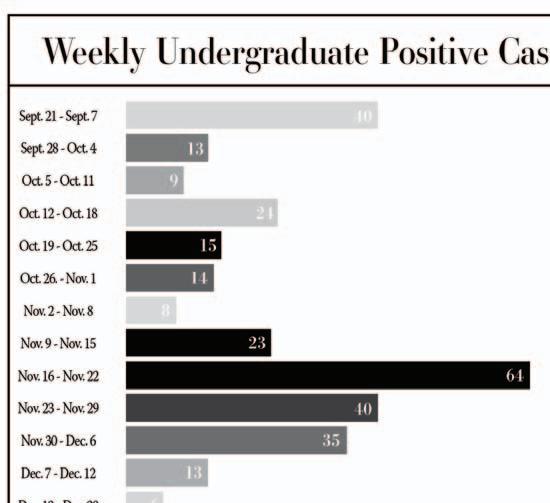
Forty-one undergraduate students were in isolation as of Friday, with 22 in isolation housing and 19 recovering at home.
There were fewer undergraduate cases than the previous week, when 38 undergraduates tested positive out of 13,923 undergraduate tests, a positivity rate of .27 percent.

Although BC inquired with the commonwealth about acquiring vaccines for students, it does not appear that the state has plans to distribute vaccines to universities, Associate Vice President for Student Engagement and Formation Tom Mogan said in an email to students on Friday.
“We strongly encourage you to pre-register for a COVID-19 vaccine appointment through the Commonwealth now and you will be alerted as to when you will be able to schedule an appointment at a mass vaccination site,” he wrote.
Students who are two weeks removed from their second Pfizer or Moderna shot, or from their dose of the Johnson & Johnson vaccine, will not have to quarantine if they
are contact traced, according to the email.
Vaccinated students who test positive for COVID-19, however, will still be placed in isolation, he wrote. In the email, Mogan encouraged students to continue to adhere to University and public health COVID-19 protocols, especially those requiring masks.
“One area of particular concern has been the increasing disregard for mask-wearing in certain areas of campus, particularly Maloney Lawn,” he wrote. “Massachusetts continues to require everyone, including vaccinated individuals, to wear masks in all indoor and outdoor public settings, even if you are able to maintain six feet of physical distance.”

Mogan also reminded students that those who test positive for COVID-19 or get contact traced in the coming weeks may have to quarantine through finals, and for seniors, through their graduation activities.
“For all students, we want you to remain healthy to be able to perform well in your classes and on your finals, and avoid quarantine and/or isolation,” he wrote. “For students who make their home a distance from campus, the choices you make in the next few weeks may have an impact on your ability to travel home at the end of the semester.”
LABC Hosts Alleged War Criminal at Conference
Uribe, from A1
The Latin American Business Conference, which took place from Monday to Friday of last week, was comprised of a series of webinars on Zoom that featured various Latin American business experts, including Fabio Coelho, the president of Google Brazil, and Marisol Argueta de Barillas, the head of Latin America at the World Economic Forum.
In Uribe’s talk, he focused on issues of security in Latin America and discussed his ideas about democratic security. He said he was often asked if his national security policy would resemble those of many dictators in Latin America.
“My answer was no,” Uribe said. “What I want for Colombia is democratic security: security for all Colombians, security with freedoms, ... security for those [who are] my
friends and for those [who are] my most radical opponents.”
Maria Alejandra Silva, a research associate at the Council on Hemispheric Affairs, said in an article that Colombia suffered “egregious” human rights violations during Uribe’s tenure.
“Among these abuses were the extrajudicial killings of thousands of FARC combatants, as well as the ‘false positives’ scandal in which Colombia’s military forces killed at least 5,000 civilians, dressed them as guerrillas, and gained bonuses from the government,” she wrote.
Colombia paid a great price for this safety and security, according to Silva.
“In sum, while President Uribe is credited with the stability and security of Colombia, this security came at a great cost to civilians and represented many gross violations of human rights and ethical governance,” Silva wrote.
The recording of Uribe’s webinar
that the club posted on Facebook garnered significant attention, accruing over 58,000 views and just under 4,000 comments, in which some people voiced their support for the former president while others expressed disdain.
“[I have] confidence to travel around the country because there wasn’t security before you were president of Colombia,” Daliris Marin Lo commented on the post. “I admired you Alvaro Uribe Vélez, the best president of Colombia ever.”
Other viewers strongly criticized Uribe and the LABC for hosting him. One commenter said that Uribe should not be an example at a leadership conference.
“Please, stop inviting [these] kinds of criminals to your conferences, this person should never be an example to follow,” Cristian Jara wrote.
In a statement to The Heights, the LABC stressed that its mission
is to increase awareness of social, political, and economic challenges in Latin America. It aims to do this by providing diverse perspectives that showcase the complexity of various political issues, the statement reads. The decision to invite Uribe, the LABC said, is in accordance with this mission.
“The opportunity to hear from a former President always brings distinctive value given the themes and topics our conference aims to address, and one that the community o f international students from Colombia and Latin America within BC, a group that the club specifically tries to represent, showed great interest in participating in,” the statement reads.
Though the club believes Uribe brought value to the conference, one commenter, Jorge Paz, strongly disagreed with this sentiment.
“You lose any credibility by inviting a mass murderer,” Paz wrote.
THE HEIGHTS A2 MONDAY, APRIL 19, 2021 TOP things to do on campus this week 3 NEWS
1 2 3
The Campus Activities Board will host a DIY charcuterie board event on Wednesday from 12 p.m. to 2 p.m. Students can pick up their own board and food package outside of Carney Hall and watch a video from BC Dining on assembling the board.
Guatemalan-American filmmaker Luis Argueta will be presenting on his upcoming documentary Ausencia on Tuesday at 12 p.m. at a virtual event titled “Another Side of Migration: Absence and the Agency of Women.”
On Wednesday at 12 p.m., the Boisi Center will host a virtual panel titled “Engaging The Social Dilemma: Social Media and the Polarization of Politics and Pews.” Participants will discuss the 2020 documentary The Social Dilemma and the impact of social media.
VICTOR STEFANESCU / HEIGHTS EDITOR
ÉAMON LAUGHLIN / HEIGHTS EDITOR
A table at the annual CAB World Fair on the Gasson Quad on Saturday afternoon.
BC Community Laments No Guest Policy at
BY
Editor AND VICTOR STEFANESCU Asst. News Editor
Boston College’s ban on guests at Commencement means Andrea Catacora will not be able to walk across the stage in front of two parents who worked for years to watch their daughter receive something they never could—a leather-backed college diploma.
“I’m first gen and … we immigrated here when I was, like, six months old, and this is, like, probably one of the biggest moments for them,” said Catacora, MCAS ’21. “This graduation is mostly for my parents.”
Catacora and many fellow seniors were left disappointed on Tuesday after University President Rev. William P. Leahy, S.J., announced that guests will not be allowed at BC’s in-person Commencement for the Class of 2021.
The announcement followed months of COVID-19 related cancellations and restrictions that prevented seniors from
participating in many traditions during their last year at BC.
Christine Swanson, mother of Jordyn Mason, MCAS ’21, started a petition on Tuesday urging the University to allow parents to attend Commencement in person.
Swanson said she created the petition in response to the outcry of parents on the Boston College Parents Page on Facebook who said they would sign a petition if one was created.
“These kids have really been great troopers through the last 15 months, you know,” Swanson said. “But I do think the graduation, which is the culmination of all their hard work, really should be shared with their parents who have been right beside them and supporting them through what has been extremely trying times for everyone.”
Despite the months of COVID-19 restrictions, Catacora said her mother still held out hope that she would be able to see her daughter graduate in person.
“She was just disappointed and confused that ... there are baseball games going on right now in Massachusetts and there’s other events that are being held with COVID restrictions in place,” she said. “And the fact that they also have to come up to move me out still, like, they’re going to be on campus as many people’s parents are.”
Dan DiCocco, MCAS ’21, said he does not understand why parents can’t attend Commencement if they will be on campus to help with moving out.
“So, it’s hard to justify how they couldn’t be out in an outdoor space when they’re all going to be coming indoors anyway to help us leave,” DiCocco said.
DiCocco said his parents have already expressed frustration over this decision.
“I mean, more than anything they’re just bummed, you know,” DiCocco said.
Colleen Fee, mother of Jack Miller, former Heights editor and MCAS ’21, said she is disappointed about missing the third graduation in her family.
“I’m still sort of absorbing the news, but I think it certainly will be disappointing to kind of be watching TV,” Fee said. “And in our family, Jack’s two brothers graduated last year, so we’re zero for three for graduations.”
Despite not being allowed to attend herself, Fee said the most important thing to her is that the students will get to experience a ceremony in person together.
DiCocco said graduation feels a little bit like a waste of time without the parents there.
“Graduation is mostly like for your parents, or it’s more for your parents than it is for you,” he said. “I don’t want to say, like, it’s not a special moment and event, but in reality, this means way more for them than it does for us.”

Joey Reda, on the other hand, said that although he’s disappointed, he’s still grateful to have an in-person ceremony.
“There’s been a lot of stuff that’s happened this year that’s not what anyone envisioned their senior year being, so relatively speaking I’m very glad we’re getting something in person,” Reda, CSOM ’21, said.
Anthony Figura, CSOM ’21, said that though his parents are upset about not attending his graduation in person, they understand BC’s decision. Figura said he completely understands BC’s decision and hopes the senior class will be grateful for the opportunity to graduate in person.
“It’s a decision that nobody wants to make, but I think at the end of the day, BC has educated us to be grateful for everything that we have and grateful for the opportunities which we’re given, and I think this is just one prime example of us being able to step up to that occasion,” he said.
Sarah Riegel, CSON ’21, said she’s upset by the announcement given the capacity
of Alumni Stadium and other Boston-area universities’ ability to invite guests to their commencements.
“I do not think they’re making a good decision,” Riegel said. “Because I know Northeastern, which has an outdoor stadium, is doing an in-person graduation with guests, and honestly that is what my friends and I all thought BC was gonna do, because it has a massive football stadium.”
Leahy cited health and capacity regulations from Massachusetts, which limit stadiums that hold 5,000 or more people to 12 percent capacity. Alumni Stadium, where Commencement is held, can hold 44,500 people, which would limit BC to 5,340 people at graduation under these guidelines.
In addition to the graduates, the ceremony will host trustees, senior administrators, honorary degree recipients, and faculty marshals, Leahy said in the email. Swanson suggested that the four schools be divided into separate ceremonies, and David Brooks, this year’s commencement speaker, could be broadcast live at each of the locations.
Swanson’s petition garnered 1,692 signatures at the time of publication. As of now, Swanson said she is aiming for 2,000 signatures on the petition and hopes to present it to the BC administration.
“I’m just simply trying to make our voices heard, help the students make their voices heard so that change can happen, and that BC will in fact honor them the way they should be honored,” she said.
Though she still thinks she’ll enjoy the ceremony, Riegel said not having her loved ones around her takes a lot of the excitement out of the day.
“I’m not dreading it, but I’m not excited about it,” Riegel said. “It’ll be nice closure, I guess, to walk across the stage, but in the end, the people I want to celebrate with me won’t be there, and that’s what matters.”
In light of last year’s Commencement being canceled, Rayan Habbab, BC ’20, said that this year’s seniors should try to enjoy their final weeks with classmates.
“At least for me personally I think that
would free up a lot of mental space to kind of really concentrate on those bonds that I made across the four years of college without having to be like stressing about what my parents are doing and like what they want to be doing,” he said.
Habbab said he understood the decision administrators made to cancel his class’s graduation.
“I mean at least me personally, I definitely wanted them to do, kind of, whatever they thought was safest and best for students and our parents as well,” he said.
But Habbab said many members of the Class of 2020 still hope for a substitute for their canceled ceremony. Catacora said though her parents might have to watch her walk across the stage from their hotel room, her family will surely still celebrate.

“We’re trying to see what we can safely do like around the city or just together when we go back home,” she said. “... They definitely want to still commemorate it and do something special.”
Catacora said she thinks administrators could have found a safe way to allow parents to attend in person.
“I feel like with the amount of effort they’ve put into COVID regulations right now on campus, and the amount of testing that they’re able to do, and the resources that they probably have, I think it could be possible and I think it wasn’t really the right decision,” she said.
Ultimately, Fee said she hopes that BC will take resources that would have been used to ensure a fully attended Commencement to create a more memorable ceremony for the graduates.
“I’m really hopeful that the University, you know, if they don’t have to worry about parents, and they don’t have to worry about managing COVID testing and contact tracing or whatever would have been involved had parents been present, I hope they take that time, energy, and money and put it into making the lead up and the ceremony itself really, really special,” Fee said.
Two Juniors Named Recipients of Truman Scholarship
BY EMMA HEALY Sports Editor
After a months-long application and interview process, two Boston College juniors, Max German and Jenna Mu, both MCAS ’22, received phone calls last Wednesday from University President Rev. William P. Leahy, S.J., informing them that they had been named 2021 Truman Scholars.
“President Leahy called me and told me the good news, and we had a conversation, and I remember … my jaw was dropping, and I was going all over the place in my mind,” German said.
Congress established the Harry S. Truman Scholarship Foundation in 1975 with the intent of cultivating the next generation of public service leaders. Recipients of the scholarship earn up the $30,000 to use toward a graduate program or their professional endeavors.
German and Mu are BC’s 20th and
21st Truman Scholars since 1981, and were each selected from a record-high 845 candidates nominated by 328 colleges and universities across the country, according to a University release.
BC is among fewer than 80 colleges and universities in the nation named a Truman Honor Institution as a result of its “encouragement of outstanding young people to pursue careers in public services, effective promotion of the Truman program on their campuses, and sustained success in helping their students win Truman Scholarships,” the release said.
German, a political science major, said that he focuses his work on the intersection of history and public policy.
Through his studies and research at BC, German said he looks to answer questions such as “what does it mean to be an engaged citizen?” and “how can you apply the founding documents to what it’s like to be a citizen when our society looks radically different?”
The lengthy Truman Scholar application process includes upwards of a dozen essays, including a policy proposal in a field related to the applicant’s interests. German said that his proposal centered around voting rights and automatic voter registration due to his background in political activism and community engagement.
“[Automatic voter registration] puts the ownership of registering voters on the government and not people having to do it themselves,” German said.
German’s affinity for public service stems from a personal connection
after earning a “second chance” at his education. Out of high school, German attended Quinsigamond Community College in Worcester, Mass., but after one semester withdrew to focus on sobriety. After some time off, German realized that his future lay in earning his college degree, and he returned to that same community college.
“It provided me a platform to kind of excel,” German said. “I was learning the diversity in the room, it was so incredible—the lessons that I was learning. … I guess I was learning life lessons in the classroom. I ended up, like, really kind of coming into my own there.”
German transferred to BC in 2019, and his choice to do so, he said, was based on a combination of BC’s “culture of service” and rigorous academics.
German has not yet decided his postgraduate plans—he is unsure whether he wants to attend law school, study public policy, or something else entirely, he said. In the meantime, German said he plans to take a year off to do service work through the AmeriCorps VISTA program, which works with nonprofit and public agencies to end poverty in the United States.
Although he is unsure of where his Truman Scholarship will take him, German said that the application process afforded him the opportunity to do deep personal reflection.

“It’s kind of funny with these things in that they kind of force you to take, like, an objective look at your life,” German said. “You really have to kind of look back and craft these narratives. … It’s like a
large examen on yourself.”
Mu’s application process led her through a similarly reflective experience, she said, one that facilitated a deeper understanding of the intersections of her four main academic interests: dentistry, service, global health, and environmental justice.
“I wouldn’t say that I’m the most traditional student,” Mu said. “So, applying for the Truman application and, you know, getting that external validation that yes, I could pursue all four of these fields and really make a difference, that just meant so much to me.”
The Truman Scholarship will allow Mu to pursue two advanced degrees—a dental degree followed by a master’s in public health. The former, she said, will allow her to pursue her interest in human-centered work and treating patients, while the latter will provide her with opportunities for more abstract thought and policy making.

“This will allow me to not only think about dental care access but actually write policies and tackle the systemic barriers to dental care access,” Mu said.
“As I mentioned my interest in environmental justice, and so again, the [Masters in Public Health] will really equip me to tackle these issues via policy.”
Mu, who is also a Gabelli Presidential Scholar at BC, crafted an independent major in global public health, which stemmed from both her interest in dentistry and the already-existing global public health and the common good minor program.
As a pre-dental student, her aca -
demic focus revolves heavily around STEM classes, so by applying for an independent major, Mu said that she was able to combine some of her major areas of interest.
“I took classes for the global health minor, which is an official minor, and I saw that they really complemented [my STEM classes], which allowed me to take the STEM knowledge and translate it into solutions in the real world,” Mu said.
Mu’s draw to service was spurred on by her brother Jesse Mu, BC ’17, who majored in computer science at BC, she said.
“It was really touching because whenever I talked to him about his field, it always comes back to … ‘I’m doing this because this is the way that I can serve as many people as possible,’” Mu said. “Then I came here and I also just saw what he was talking about, like the holistic education, the service-oriented education, you know, being people for others.”
THE HEIGHTS A3 MONDAY, APRIL 19, 2021
Graduation
JULIA KIERSZNOWSKI Assoc. News Editor AMY
PALMER Asst. News
COURTESY OF JENNA MU
Jenna Mu plans to get a masters in public health after she graduates from BC.
COURTESY OF MAX GERMAN
Max German plans to work in the AmeriCorps VISTA program after BC.
With each passing game, No. 5 Boston College lacrosse proves its dominance on the field more and more, including most recently with two victories over No. 4 Notre Dame. Win after win, the Eagles put the ACC—and the nation—on watch.
BY EMMA HEALY Sports Editor
Two years ago, almost to the day, Boston College lacrosse hosted its Senior Day, capping off an undefeated regular season and honoring a dominant group of seniors with a win over Louisville. Fast forward one year, and instead of competing one last time in Alumni Stadium, BC’s seniors were at home, sidelined by the COVID-19 pandemic.
Fast forward one year further, and the No. 5 Eagles (11-, 7-1 Atlantic Coast) had a shot at redemption. Not redemption for the loss of a game, but for the loss of a season. The NCAA awarded an extra year of eligibility to all spring sports athletes as a result of last season’s early conclusion.
Though not all of BC’s seniors opted to cash in on that deal, the Eagles honored two groups of seniors in an 18-12 win over No. 4 Notre Dame (6-5, 3-5) on Saturday.
Attacker Cara Urbank and defender Jillian Reilly were BC’s only two 2020 graduates who opted to return for another year, but BC honored both them and

three other 2020 seniors—Sheila Rietano, Morgan Tedeschi, and Kate Taylor—after Saturday’s win. Also in on the celebrations were eight of BC’s current seniors, including Charlotte North.
Urbank and North have been BC’s one-two punch on the attacking end all season. The same was true on Saturday, as the duo combined for 10 of BC’s 18 goals. North found the net six times to lead the Eagles, and Urbank added four. Urbank also tacked on a team-high two assists.
The game followed a strikingly similar pattern to BC’s earlier matchup with Notre Dame on Thursday, including a nearly mirror-image final score. In each game, a Weeks sister opened the scoring: on Thursday it was Courtney, and on Saturday it was Cassidy.
Cassidy Weeks’ opening goal came just over a minute into the contest and set the tone for BC’s fast-paced, relentless offense. The Eagles followed her tally with four unanswered goals to rack up an early, seemingly insurmountable lead that never went away.
BC went on another four-goal run in the later minutes of the first half and held Notre Dame nearly silent through 30
minutes, so the Eagles headed to the locker room after one half with a commanding 9-3 lead.
The certain loss of Urbank and the potential loss of North after this season— though North still has one year of eligibility remaining—seems daunting, but BC’s underclassmen are packed with talent, which was on full display on Saturday.
After North and Urbank, junior Cassidy Weeks recorded two goals, her redshirt sophomore sister Courtney had three goals, and sophomore Annie Walsh and freshman Belle Smith each netted one.
Up to this point in the season, Smith has recorded 30 goals in just 12 games— the third most on the team—even without starting a single contest. Though her impact didn’t show up on the stat sheet as much on Saturday as it usually does, Smith was a force to be reckoned with on the defensive end, causing turnovers and shutting down the Fighting Irish’s hopes for a comeback.
Notre Dame began to show signs of life in the second half. Though the Eagles dominated through the first 30 minutes, the Fighting Irish looked like a new team coming out of halftime. Urbank netted
the first goal of the second half, but Notre Dame followed her with three unanswered goals, two of which came from Madison Ahern. After 10 minutes of the second half, Notre Dame had cut its deficit to 12-6.
BC responded with three of its own to retake a nine-point lead, and from then on, the teams went practically goal-for-goal.
Senior goaltender Abbey Ngai came in for the final four minutes of the contest, along with a number of her fellow seniors off the bench. Ngai allowed three goals, one of which came as the horn sounded and BC’s win was already beyond doubt.
Ngai has seen severely diminished playing time since leading the Eagles to a National Championship title game in 2019 with the arrival of Rachel Hall. Hall, in net for the majority of the contest, finished with seven saves.
It’s unclear what the future holds for most of BC’s seniors—whether or not they will return for one final season on the field—but one thing’s for certain: after an eight-game win streak, four of which came over opponents ranked in the top 10, BC has a full head of steam for the final leg of the regular season with no signs of slowing down.
Ott: College baseball should be the testing ground for rule changes.
The 2021 College Football National Championship game drew over 25 million television viewers. The men’s basketball national championship game drew just under 17 million viewers, and the women’s game drew over four million.
College baseball is not—and has never been—relevant to the average sports fan. The biggest event of college baseball in 2019—the College World Series game three—drew just a fourth of the audience of each episode of Judge Judy, and to make matters worse, that was the most-watched College World Series in over five years.
Over the last couple of years, the MLB has attempted to increase its appeal through a number of pace-of-play ordinances. As professional sports such as football and basketball have recently become more popular, baseball seems to have remained stagnant, leading some to claim that the MLB is dying.

College baseball is not dying. It’s already lifeless in an iron casket buried thousands of miles underground, coming up for air every once in a while when people get bored enough of March Madness and college football to wonder why college baseball is so irrelevant.
Things might seem hopeless, but they don’t have to be.
Baseball is still one of the most popular sports in America. College baseball has the potential for similar widespread appeal, but it has not lived up to it. College basketball and football are both popular in their own right because, compared to their professional counterparts, they are faster paced, can feel more authentic, and fans can watch players develop.
Baseball fans have a difficult time watching players develop to a professional level in their college years, as even top prospects tend to spend years in the minor leagues. Still, college baseball could take steps to make itself stand out from its professional counterpart.
The NCAA needs to meet—and go beyond—the MLB’s efforts to increase pace of
BY ASA ACKERLY Assoc. Sports Editor
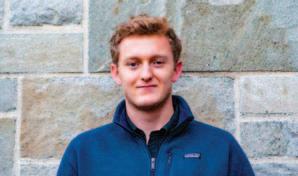
Going into Sunday’s series finale against No. 18 Florida State, Boston College baseball had been waiting quite a while to get a win. The Eagles came into the weekend on a three-game losing streak, and, after dropping the first two games of the series in convincing fashion, their winless streak was inching to almost two weeks long.
Two lengthy weather delays stretched out BC’s dry spell just a little bit longer, but over five and a half hours after the game had originally been scheduled to start, the Eagles (15-18, 5-16 Atlantic Coast) finally put the finishing touches on a 5-3 victory over Florida State (18-13, 12-9) and got back in the win column. For the first time in what felt like ages, the storm clouds—both literal and metaphorical—finally lifted.
The game was slated to begin at 1 p.m., but the first pitch didn’t come until 3:32 p.m., as rainy conditions in Tallahassee forced the grounds crew to get the tarp out.
After the first two innings passed quietly thanks to strong pitching from BC starter Alex Stiegler and Seminoles’ hurler Conor
Grady, the Eagles struck first with a pair of runs in the third.
Dante Baldelli led off the inning with a stand-up triple and the Eagles were the beneficiaries of some good luck, as an error by Nander De Sedas on a ground ball from Peter Burns allowed Baldelli to score.
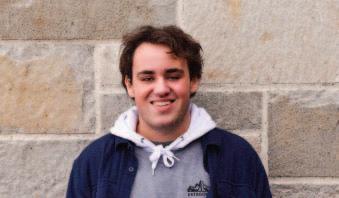
Cameron Leary’s groundout advanced Burns to third, and Sal Frelick put the second run on the board off a fielder’s choice.
The Seminoles came roaring right back in the next frame, however, as Matheu Nelson stroked a double to lead off the inning. Robby Martin followed it up with a two-run shot over the left-field wall and off the scoreboard.
Stiegler’s struggles continued in the fifth inning. He walked the first two batters of the inning, and he advanced the runners on a wild pitch. Despite Stiegler sending the next two batters back to the dugout, BC head coach Mike Gambino had seen enough and turned the ball over to Joey Walsh, who got BC out of the jam.
Stiegler ended his day with a final statline of 4.2 innings thrown, six baserunners allowed, and four strikeouts. It was the third outing in a row in which he allowed three runs or fewer, showing a promising return to his early strong form after a couple of rough outings in March.
BC took the lead again in the fifth off a pair of hits from its usual suspects. Frelick hit a two-out double into the right-field corner, and Brian Dempsey scored him on a single to right field.

The rain returned after the conclusion of the fifth inning, and the two teams returned to their dugouts once more. While college rules dictate that games can be called for weather-related reasons as long as five innings have been completed, the rain subsided after about an hour and the game continued.
The Eagles’ bats stayed warm despite the delay, and BC doubled its lead in the sixth off of a pair of hits from Ramon Jimenez and Jack Cunningham, and a sacrifice fly from Baldelli.
Florida State cut the deficit to one once again in the seventh after Walsh walked a pair of batters and allowed an RBI single to Nelson, but BC pushed the lead back to two in the eighth off a homer from Lucas Stalman—the first of his career.
The one-run shot was Stalman’s first RBI of the season and came on just his eighth at-
bat of the year. Stalman featured in all three games against the Seminoles due to Luke Gold’s absence from the lineup.
Walsh kept things interesting in the ninth by allowing a pair of walks but got back-toback flyouts to end the frame. Walks were a problem all day for Walsh, as six Seminoles saw ball four during his 4.1 innings of work. He was nearly perfect apart from that and allowed just one hit while striking out four. He received credit for the win, while Florida State starter Grady took the loss.
A4 THE HEIGHTS
MONDAY, APRIL 19, 2021
JESS RIVILIS / HEIGHTS SENIOR STAFF
Boston College Florida State 5 3
ACKERLY On Second Thoughts See Rule Changes, A5
Clutch
Relief To Snap Losing Skid
ASA
Walsh
In
JESS RIVILIS / HEIGHTS SENIOR STAFF
Dame Boston College 12 18
The Eagles rebound from two losses to open the weekend with a nailbiting 5-3 win over Florida State on Sunday.
Notre
Jay McGillis Memorial Spring Football Game Saturday, April 24, 11 a.m.
ETHAN OTT
BY ETHAN OTT Asst. Sports Editor KELLY DI LUCCIO Heights Staff
After opening its four-game weekend series with three straight losses to No. 17 Clemson, Boston College softball was looking to close out the series on a different note on Sunday afternoon. Fresh off a devastating extra-innings loss on a walk-off error, the Eagles seemed like they might have enough fight left and a big enough chip on their shoulder to finally outlast the Tigers.
Clemson (31-4, 21-4), however, was hungry for a series sweep and to add to its 11-game win streak. The Tigers brought the same high energy as their last three wins over the Eagles (8-24, 4-16). After seven innings, Clemson pulled away with its fourth win of the weekend and brought its overall win streak up to 12 with a 6-0 v ictory.
Valerie Cagle pitched her second no-hitter of the week, ending the game with 250 career strikeouts. Her dynamic pitching proved to be an issue for the Eagles, who struck out a total of nine times.
Clemson took off with an early lead and played lockdown defense from the outset. The Tigers ended the first inning ahead by one, thanks to an RBI double by Cagle that allowed
McKenzie Clark to slide into home.
Clemson added another one to the board at the bottom of the second as Clark singled up the middle, sending Carlee Shannon, who was pinch running for Kyah Keller, into home. BC, on the other hand, struggled—as was the case all game long.

BC held the Tigers quiet in the third after Clemson’s Marissa Guimbarda reached on a single to lead off the inning. Arielle Oda came in to pinch run, but she did not make it past second, as BC’s starter Peyton Schnackenberg retired the next three Tigers in order.
The Eagles also held their own in the bottom of the fourth, holding the determined Tigers scoreless and hitless. But, despite some defensive momentum, BC’s offense failed to find a spark as the top of the fifth followed with a swift BC strikeout and two groundouts.
Cagle started off the bottom of the fifth strong for Clemson, hitting the ball out of the park and advancing the Tigers’ lead to 3-0. Clemson’s next two batters reached base as well, leading to runners on first and second with no outs. Schnackenberg retired the next two Clemson hitters before Alia Logoleo stepped up to the plate and broke the game open.
With one swing of the bat, Logoleo brought Clemson’s lead up to six. That was the last run Clemson would score and the last pitch Schnackenberg would throw. After Schnackenberg
BC softball managed just
gave up the three-run play, BC head coach Amy Kvilhaug switched things up and brought in CC Cook to pitch in relief. Cook quickly worked her way out of the inning after Cammy Pereira grounded out to first, but the damage had been done.
Cagle continued her dominance in the sixth, striking out one Eagle and forcing two to ground out. Cook was similarly successful in the bottom of the inning, managing to hold Clemson scoreless despite allowing a walk and a hit.
When BC took its last chance at the plate in the top of the seventh, prospects were all but hopeless. Cagle
already had eight strikeouts over six innings, and the only Eagle to reach base all game did so on a second-inning Clemson error.
Cagle added another strikeout to her resume in the seventh, as she retired BC’s batters in order with a strikeout looking and two groundouts.
While Sunday’s game was BC’s worst offensive showing of the weekend, the Eagles’ bats did not look much better in their other three weekend matchups with Clemson. In four games across the weekend, BC scored just five runs while allowing 26.
Pitching and lack of offense were
not the only challenges for the Eagles throughout the Clemson series, as they also recorded at least one error in each of the four games. BC had just one defensive flub Sunday, but had a total of five over Saturday’s two games and an additional two on Friday.

Clemson’s sweep of BC came just after the Eagles showed signs of a late effort to turn their season around.
BC entered into the weekend series riding a two-game win streak after splitting a four-game series with Syracuse. Nonetheless, that momentum proved to be just a momentary hot streak in an otherwise bleak season.
BC Drops Season Finale to Wolfpack
BY JOHN SCRIMGEOUR Heights Staff
Stats don’t always tell the whole story. Boston College women’s soccer led by one at the half of Saturday’s matchup with NC State despite being out-shot, out-possessed, and outplayed. In the second half, the Eagles played arguably a cleaner game, yet they conceded three goals and scored none.
The drastic difference from half to half led to a 3-1 loss for the Eagles (3-10-1, 1-7-0 Atlantic Coast). Prior to the matchup, the Eagles were 13-4 all time against the Wolfpack (5-3-1), which did not play in the fall half of the season.
BC’s only goal came early in the game, when captain Jenna Bike headed one home off the service of sophomore midfielder Sam Smith. Smith leads the Eagles in scoring with 13 points on five goals and three assists.
Bike’s goal was one of the two firsthalf shots on goal from the Eagles. NC State had six shots on net in the first 45 minutes, all of which BC sophomore goalie Allie Augur handled with relative ease.
In the second half, there were plenty of chances from both sides. NC State found the equalizer it had been looking for in the 54th minute. A loose ball bounced out to forward Toni Starova, who struck one into the lower right-hand corner from 25 yards out.
The goal came off a sequence of
consecutive BC turnovers in the Eagles’ end due to a high-pressing NC State front line.
For the next 20 minutes, the two sides went back and forth. BC’s backline seemed to slow things down, and the Eagles built up some dangerous counterattacks. In the 73rd minute, however, a slip up from Augur in net found BC trailing 2-1 with 17 minutes to go.
The second NC State goal sent the Eagles into overdrive on offense, but the constant high pressure wasn’t enough.
BC’s best chance to tie things up came with five minutes to go, on a one-on-one attack from Bike which easily could have resulted in the referee pointing to the penalty spot.
Instead of a foul, BC received a
corner kick. Off the kick, two Eagles powered the ball into the net, taking NC State’s goaltender down with them. Though the Eagles thought they had tied it, officials called the goal back on a foul.
Two minutes later, Starova converted on a 2-on-1 for her second tally of the game, and NC State expanded its lead to 3-1.
The score remained 3-1 in favor of the Wolfpack when the final whistle blew three minutes later.
NC State outshot the Eagles 14-7, including a 9-4 edge in shots on goal. The teams also combined for nine total fouls, four against the Wolfpack and five against BC. With the loss, BC concluded its unusual year, as the season was split between the fall and the spring.
play and attract larger audiences.
While college baseball games are already shorter than MLB games, the difference is not enough to attract fans. Baseball is a fundamentally slow game, but little changes can make a difference. One change could be a rule that the MLB has already adopted: starting extra innings with a runner on second. The NCAA gave conferences the option to adopt this rule, but none have.
The MLB should not be ground zero for pace-of-play testing. College baseball should take on that burden. Even if the pace of play remained relatively unaffected— which is unlikely—rule experimentation would at least give college baseball the distinction from the MLB that it desperately needs.
At-bat minimums for pitchers, time limits between pitches and batters, limited mound visits, and reduced time between innings would also help. There is no need to fundamentally change the game of baseball—it has a wide enough appeal and has stood the test of time—but baseball also should not remain stagnant while the rest of the world speeds up.
Baseball in general is facing a problem, and college baseball is facing an even bigger one. The NCAA should get more adventurous with rule changes and experimentation to draw larger crowds and widen appeal.

College baseball, like the MLB, can move forward while still embracing tradition and should start making changes now.
Ackerly: The NCAA should make sure baseball is played in its purest form.
The argument for instituting the runner on second rule in the MLB was simple: Baseball games are too slow and too static. The assurance of action in extra innings and that the number of innings will not
stretch deep into the teens will bring more fans to the ballpark and make them switch their TVs from, say, the Minnesota Timberwolves to the Minnesota Twins.
Purists be damned, the change worked as it was meant to.
Are games ending faster? Definitely. Extra innings games ended in the 10th inning 69 percent of the time in 2020, compared to just 46 percent in the three preceding years. Last season was the first in over a century in which not a single game went longer than 14 innings.
Are more people watching these games? Also a resounding yes. It will take more time to evaluate the impact on attendance as the 2020 season was played behind closed doors, but the hope of getting more eyeballs was fulfilled. MLB.
TV’s viewership doubled for extra innings compared to years prior because people are actually turning the games on for extra innings rather than off.
While the change worked in accomplishing the MLB’s aims, this does not mean the NCAA should institute the rule in the college game. In baseball’s war between staying true to its traditionalists and drawing in the masses, the MLB threw history to the wind in an appeal to the bottom line.
College baseball is not in a situation where it has to make that choice. Attendance and viewership have dipped at the pro level, but interest in college ball is on the rise.
Viewership for the College World Series has steadily trended up over the past two decades, and the 2018 and 2019 finals were some of the most watched in recent history. The decisive third game of the 2019 series between Vanderbilt and Michigan was the most-watched baseball game on ESPN that year.
Attendance figures have been similarly
strong. Live attendance at the championship has also been on the rise, and the overall attendance at the event has not dipped below 300,000 since it first surpassed the milestone in 2006.
Regular season attendance has also ticked up this century at a regular clip, and stadium expansions at a number of the top programs have been a boon for the increased turnouts. The leaders in attendance each season are also very consistent and not strictly tied to the performance of the program that year, proving that these fanbases are largely comprised of consistent, hardcore supporters.
Given this trend, the czars of the college baseball world have no reason to change what has become a stable, winning formula. College baseball is trending in the opposite direction of the MLB, and it relies on a constant group of fans that have shown no signs of going anywhere. Risking the frustration of these loyal supporters in the hope of attracting new demographics that do not exist is a fool’s errand.
The rule is also unpopular with the people who these games are ultimately for: the coaches and players. Although the NCAA allowed conferences the option of instituting the change this season, none have opted to do so as of yet.
Dave Van Horn, head coach of Arkansas—which is one of the top baseball programs in the nation and consistently draws large crowds—recently spoke out against the possibility of adopting the rule, saying he prefers “regular baseball.”
While college basketball and football have become fester pits for endless commercialism and profit making, college baseball has stayed abreast of these trends. It’s a laid back affair, with a steadily growing group of loyal fans enjoying some pure baseball.
Let’s keep it that way.
MLB has undergone
A5 THE HEIGHTS MONDAY, APRIL 19, 2021
0 6
Boston College Clemson
IKRAM ALI / HEIGHTS EDITOR
Cagle’s No-Hitter
Sweep of BC
The
recent changes, leaving the NCAA with a tough decision.
Finishes Tigers’
JESS RIVILIS / HEIGHTS SENIOR STAFF
five runs across a four-game weekend series, while Clemson put up a staggering 26 runs in that span.
Should the NCAA Adopt MLB
Changes? Rule Changes, from A4 Boston College NC State 1 3
Rule
BC Should Allocate More Funds to Campus Ministry To Employ Non-Catholic Chaplains
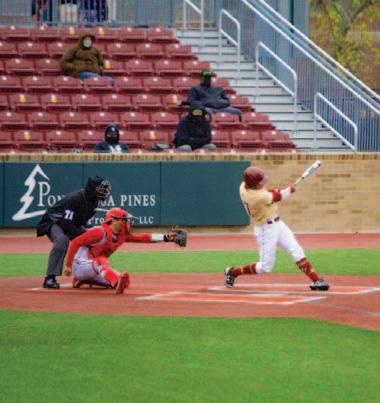
Boston College should allocate more funding to Campus Ministry so that it can expand its staff by hiring chaplains of other faiths.




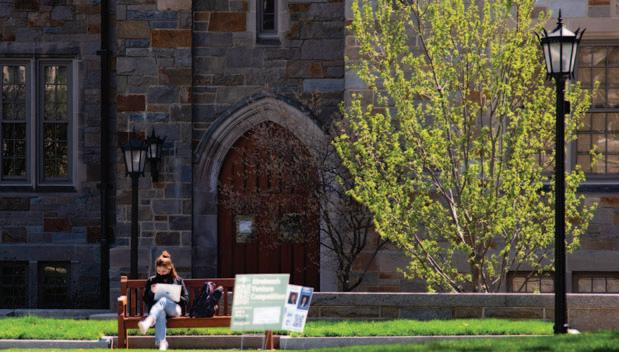
Campus Ministry is an integral part of many students’ experiences at BC, regardless of their religious affiliation. It sponsors several retreats and service immersion programs that it stresses are “open to students of all faith backgrounds and experiences.” These programs are an important part of the BC experience for many students.
Though grounded in Jesuit Catholic tradition, Campus Ministry makes a genuine effort to be welcoming to students of all backgrounds. Its website includes a comprehensive page on the multi-faith community on campus. Some of the resources it lists include the multi-faith chapel located on campus, off-campus places of worship for various faiths and denominations, and information on 16 different student faith groups.
Campus Ministry also has one minister for multi-faith programs and one multi-faith graduate assistant. These staff members are valuable resources for the student body, but there are not enough of them.
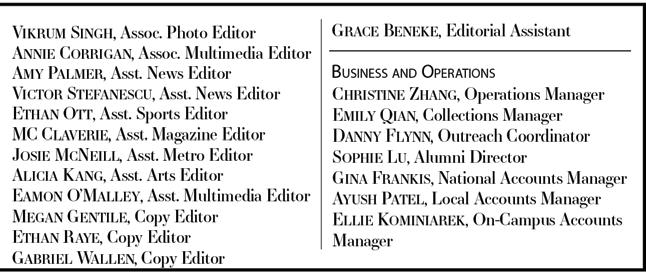

Especially during a pandemic, needing to go off campus to find a place of worship is a challenge for students. This obstacle coincides with a widespread strengthening of faith during the pandemic, as more people have turned to religion during the turbulent times. Seventy-nine percent of Catholic Americans who worship regularly say that their religious services have moved online, but a fundamental aspect of religion is community, which is strained when mass is held online. This disconnect and isolation place a greater emphasis on the need
Week in Photos
for meaningful and inclusive faith resources.

It is important for students to have access to a chaplain of their faith tradition on campus, as such access contributes to the overall well-being and success of students—especially those who are part of a minority religious group on campus. In a study conducted by UCLA, students in college and higher education who are part of faith communities on campus experience growth in self-confidence and composure, which enhances GPA, leadership skills, and physiological well-being.
Religion is an integral part of many students’ experience at BC and the pandemic has strengthened this faith, making Campus Ministry’s role more important, but also more demanding. In order for Campus Ministry to best serve BC students, it needs resources to expand its staff to include more chaplains of other religious denominations.
One of the important duties university chaplains have is to advocate for their students. It is relatively easy to be Catholic on BC’s campus. Campus Ministry has robust resources for Catholic students, including four different chapels on campus, St. Ignatius Church, and several masses every day.
It is more difficult to actively practice another faith at BC. Currently, the responsibility of advocacy rests on the shoulders of student leaders in faith groups, who do incredible work.

For example, in observance of Ramadan, the Muslim Student Association (MSA) collaborated with Campus Ministry and BC Dining to make food and prayer spaces available at the necessary times for students who are fasting. MSA has also coordinated the service of special food for students
who are fasting, including dates and Halal chicken. Suhoor (sunrise) meals are available Monday through Saturday on campus for pick up at 3 a.m with special bus transportation for students on Newton.
This program is an impressive example of collaboration between students and administrators, but it should not be the responsibility of Muslim students to ensure that they have the resources they need to celebrate Ramadan. Having a fulltime Muslim chaplain employed by Campus Ministry to advocate and organize programming for Muslim students would be valuable.
Georgetown University, another university whose campus ministry is shaped by its Jesuit tradition, has several multi-faith chaplains within its campus ministry, including a rabbi, an imam, a Hindu priest, a Protestant minister, and an Orthodox Christian minister, in addition to four staff members who specialize in some aspect of interreligious coordination.
BC should increase funding for Campus Ministry so that it may expand in a similar manner. Jesuit spirituality is based on justice and solidarity with the poor and excluded, and “collaboration is at the heart of contemporary Jesuit mission.”
Providing leadership within Campus Ministry for minority religious groups on campus aligns with the Jesuit mission. Further, interreligious dialogue is a core Jesuit value, so BC should make it easier for students and Campus Ministry to facilitate such dialogue and foster vibrant faith communities on campus. Allotting more funds to Campus Ministry so that it can hire multi-faith chaplains would help accomplish this.
THE HEIGHTS A6 MONDAY, APRIL 19, 2021 EDITORIAL
Top photos, left to right: BC outfielder Chris Galland bats against NC State, Sunday, April 11; BC attacker Charlotte North and Notre Dame senior midfielder Andie Aldave face off, Saturday, April 17; BC attacker Charlotte North celebrates after scoring a goal, Saturday, April 17; BC attacker Charlotte North passes the ball to BC midfielder Hollie Schleicher, Saturday, April 17.
Bottom photos, left to right: Students walk across and spread out on the Quad enjoying the warm weather, Wednesday, April 14; A student studies on a bench outside of Fulton Hall, Wednesday, April 14; Cherry trees bloom on Middle Campus, Monday, April 12.
(ADITYA RAO/ HEIGHTS STAFF); (JESS RIVILIS/ HEIGHTS SENIOR STAFF); (NICOLE VAGRA / HEIGHTS STAFF).
Breathe Easy and Get a Houseplant
door concentrations of carbon dioxide becomes even more concerning when you learn that air pollution levels are much higher indoors than outdoors. Concentrations of carbon dioxide indoors are usually around 1,000 ppm, and sometimes can range between 2,000 ppm and 5,000 ppm in poorly ventilated areas. These concentrations pose the question of how we respond biologically when exposed to such high levels.
Earlier this semester, my roommates and I had to endure an unfortunate reality that has been all too familiar to Boston College students this year: quarantine. Per Massachusetts regulations, BC requires students who test positive for COVID-19 to isolate for a minimum of 10 days and those who come into close contact with someone who has tested positive to quarantine for at least seven days since last contact. While serving this time in quarantine or isolation, BC students must not leave their rooms, rendering them with no opportunity to go outdoors.
Not being allowed outside was by far the worst part of my quarantine. Sitting in front of an open window was the closest thing I had to being outside, and if you saw my roommates and me sitting in the window sill like cats during that week, feel free to forget that memory.
One godsend during our quarantine was the houseplants we had in our common room. Watering them gave us a task for the day and watching them grow was something to look forward to (I am aware of how this sounds. Quarantine is a serious sanity test).
In taking care of these plants, however, I remembered a discussion about indoor carbon dioxide levels from an environmental class. Most times when you hear about carbon dioxide levels, it is in the context of fossil fuels and the alarming rate at which carbon dioxide levels are rising in the atmosphere. Climate scientists predict the world is on track to approach 685 parts per million (ppm) of carbon dioxide in the air by 2050. This highly concerning level would prevent us from stabilizing the temperature increases of the 21st century.
The alarm that has been sounded about out-
High indoor carbon dioxide concentrations are detrimental to physical and mental health.
Researchers found that people’s decision-making skills moderately declined at 1,000 ppm, and that those skills substantially declined at 2,500 ppm.


The effects of indoor carbon dioxide concentrations have even been given a name: sick building syndrome, which is categorized by irritability, difficulty concentrating, fatigue, and even nausea.
One study measured cognitive abilities between people working in a typical building and those of people working in a “green” building, which followed protocols of ventilation and sustainability put forth by the U.S. Green Building Council’s Leadership in Energy and Environmental Design (LEED) rating system. The results showed that all measures of cognitive function tested stronger in the green building, with the largest differences observed in the crisis response, information usage, and strategy categories.
One of the indoor areas that is most susceptible to high levels of carbon dioxide is classrooms. Researchers have found evidence that carbon dioxide concentrations in schools are consistently at the levels that caused disturbances in the aforementioned study. Elementary schools in California and Texas, for instance, measured concentrations ranging anywhere from 1,000 ppm to 3,000 ppm.
Although no studies were specifically done in university classrooms or dorm rooms, it is a fair assumption that levels would be comparable to elementary school classrooms or the offices used in the green building study.
It should be noted that a Danish study, on the other hand, said that the correlations are due to
differences in overall mental ability of participants. It also held that the spaces where tests were conducted to measure baseline carbon dioxide in buildings, like the elementary schools in California and Texas, often had a high density of people, which could have contributed to the higher carbon dioxide levels. But, most office spaces and schools consistently have a high density of people, so perhaps they can still be considered relevant.
Nonetheless, wherever the carbon dioxide is coming from, it is still causing more harm than good. Fortunately, there is a completely natural and even aesthetically pleasing method to reducing carbon dioxide levels: houseplants!
NASA was the first to discover the purifying ability of houseplants. Its study, motivated by keeping air clean in space stations, found that indoor plants can eliminate volatile compounds that often pollute our indoor spaces. The cleansing ability of houseplants is because of the bacteria in soil. Further, indoor plants are reported to improve the gamut of physical health, leading to higher happiness and creativity levels, fewer distractions, and better task performance.
The magic number is three—just three potted plants in an average indoor room can reduce the concentration of harmful air compounds significantly.
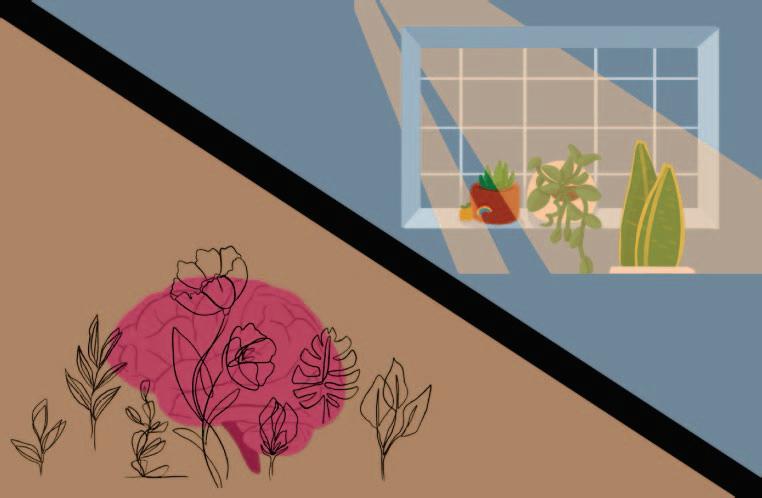
There is still plenty of research to be done regarding indoor carbon dioxide levels and the role of plants in reducing them, and luckily, there is motivation that will likely prompt this research. Spending more time in and around nature, even if it is by spending time with a small plant in a dorm room, has been shown to positively affect a person’s mood and energy levels. So, whether in quarantine, isolation, or just in need of a mood boost, everyone should get a houseplant.
Alli Hargrove is an op-ed columnist for The Heights. She can be reached at allison.hargrove@bc.edu.

Pilot makes erasable writing tools, including the god-tier of erasable highlighters. They don’t smudge, they don’t bleed through textbook pages, and they’re completely erasable.
Budding Hope: Dialogue on Mental Health
April 19 is finally here, which means that COVID-19 vaccinations are available for everyone 16 and older in Massachusetts. Pre-register for an appointment online or use Vaxfinder to find available locations. Getting vaccinated means that life at BC, and in general, can slowly start to go back to normal, which is definitely a thumbs up!


Spring has always carried a sense of new beginnings for me, so I always look forward to it. My fondest memories of spring are not necessarily the big moments, though. It is the small changes that do not significantly alter my schedule or my habits that impact me most. The birds in the morning that wake me up, the smell of coffee mixed with fresh morning dew, the warmth of the sunshine masked by the soft brush of wind—these aspects of springtime make the weight of the mundane, everyday things feel lighter. Like the feelings spring brings along, when I was diagnosed with a major depressive disorder, everything I saw around me realigned. I felt lighter. It was my new beginning.
I am one of millions of Americans who experience some sort of mood disorder in their lifetime. I think this statistic made the diagnosis relieving. The fact that so many of us have brains and bodies that malfunction made me not feel alone, and made it easier to accept myself.
It was really difficult for me to gather enough self-esteem to talk about mental health, especially on social media. But, as this generation has grown older, I have seen more people open up on a variety of platforms. Conversations about mental health
have expanded, but I questioned why I typically see more discourse on mental health on stereotypical “young people platforms” like Snapchat, Instagram, and TikTok. Older generations often use social media to attack kids for their desire to seek acceptance from others, driving a wedge between emotionally honest young adults and emotionally uninterested older adults. This divide then limits everyone’s ability to destigmatize mental health.

Sometimes, this means that younger people stick to those digital platforms that are targeted toward us, like TikTok and Instagram. My friend Kevin has started posting on Instagram about his own personal experiences with mental health, calling it “Therapy Tuesday,” and opening up about a wide array of topics that otherwise are only talked about in whispers. In response, many people around my age left comments of support and appreciation for his honesty.
Contrast this with conversations with older generations, where I have had to defend my own use of therapy and the mere validity of my diagnosis—is it really a surprise that the younger generation can’t seem to find a common ground in which they can talk about mental health? Comments I have received when talking about my depression always seem to be “Oh but you don’t seem sad!” and “Well if I need therapy, I just do x, y, and z!” But these comments tend to always come from the same people who have toxic or detrimental coping mechanisms for their own (obvious) mental health issues.
To some degree, the sentiments adults have are reflected in the younger generation. It seems too easy to quickly post some sort of infographic online dedicated to the idea of “destigmatizing mental health.” People also use social media platforms to put their best foot forward, which typically involves constructing a false narrative that they are happy and carefree, and in turn, neglecting the concept of mental health altogether.
So, the challenge of opening up about mental health has therefore been placed almost entirely on the shoulders of this younger generation. My generation has been met with little to no respect from the older generation surrounding this topic, conveying the sentiment that we are not valid for posting or talking about mental health. It is imperative that we destigmatize mental health among older generations.
Because of my generation, the future of society is going to be deeply rooted in emotion, but having emotionally inept adults now is only going to perpetuate the strain between “old” and “young” people that we already see now in other arenas like fashion trends and politics. With rising rates of depression and anxiety in younger generations, mental health should not be a “young person issue,” but rather an “every person issue,” because we are all human, and everyone’s mind is equally fallible.
Ana Pirosca is an op-ed columnist for The Heights. She can be reached at ana.pirosca@bc.edu.

The opinions and commentaries of the op-ed columnists appearing on this page represent the views of the authors of those particular pieces, and not necessarily the views of The Heights
For those who had good weather on their minds, unfortunately this Friday was a one-day hiatus. What weather apps called a light rain storm became heavy snowfall in the middle of April. Hang tight though, Tuesday is due to be 70 degrees and sunny once again.
Spring and fall in the Northeast are defined by erratic temperatures that require a dynamic closet. Just when it seems time to ship snow boots and winter jackets back home, it snows in April, and that sundress sitting in your closet is obsolete.
THE HEIGHTS
ANA PIROSCA
MONDAY, APRIL 19, 2021 A7
ALLI HARGROVE Erasable Highlighters COVID-19 Vaccines
in April Dressing For All Seasons
Snow
GRAPHIC BY MEEGAN MINAHAN AND OLIVIA CHARBONNEAU / HEIGHTS EDITORS
ing
By Eleanor Crowley Heights Staff Isabella Thorpe Heights Staff
For Patrick Lazour, BC ’13; Sarah Lunnie, BC ’08; and Bryce Pinkham, BC ’05, Boston College served as a springboard to eventually becoming a playwright, dramaturg, and Tony Award–nominated actor.
All three were at different points in their careers, but last spring, they shared a common experience—the COVID-19 pandemic temporarily halted their careers. Despite the drastic effect of COVID-19 on the performing arts industry, all three have found new avenues to express their love for the performing arts and share it with their audiences.
BEGINNING STAGES
Music and theatre surrounded Lazour’s life from an early age, he said.
“I always loved the theatre,” Lazour said. “I was a big Andrew Lloyd Webber fan when I was a kid because my dad would play cassette tapes like Phantom of the Opera and Les Misérables, though I know Les Mis isn’t Andrew Lloyd Webber.”
Lazour first discovered his love for playwriting when he and his brother wrote their first musical for a middle school play
department, he said.
The premiere of The Grand Room at BC gave Lazour the courage he needed to pursue playwriting as a career after graduation, he said.
“[The Grand Room] really served as a springboard for my time after school,” Lazour said. “I think it gave me a lot of confidence. I really believe that that step was sort of the first step in solidifying my collaboration with Daniel, my brother.”
For Pinkham, his experiences on stage at BC instilled a similar assurance—his passion for theatre could transform into a real career after graduation.
After entering his freshman year, the world of theatre drew Pinkham in, both socially and creatively. During his four years at BC, he appeared in nine different shows, and he was president of the Dramatics Society. For his work-study, he built sets and made costumes at Robsham Theater, he said.
His theatre experience at BC wasn’t exclusively success stories, though. When Pinkham was a sophomore, he starred and had a monologue in La Bête at BC, where he had his first experience entering the white room—a term performers use to describe the void one enters after forgetting their lines that may leave them mentally and physically frozen.
He performed his role in a way aimed at making his friends in the audience laugh
finding new shows by current American writers for the festival and co-editing the Humana Festival play anthologies, which she fell in love with, she said.
After graduating from BC, Pinkham was accepted into the Yale School of Drama. The day after he graduated from Yale, he already had a rehearsal for a show. He was in Beyond Therapy, where he played an outlandish character who entered the stage only to get laughs.
He had always joked that he would work as a waiter after graduation, and here he was waiting tables—it was just on the stage.
After Pinkham graduated from Yale and Lazour graduated from BC, both further pursued their careers in New York City.
When Pinkham moved to New York, he worked three part-time jobs. Within nine months, he got his first gig in an off-Broadway show—Bloody Bloody Andrew Jackson Two years later, he made his Broadway debut in a production of that same show.
Despite these successes, Pinkham always wondered where and when he would receive his next paycheck. He promised himself that if by his 30th birthday he did not love the lifestyle of an actor, he would walk away.
“You never know where the money is going to come, and you never know where the success, however you would define success, would come,” Lazour said.
Despite the unconventional and unpredictable nature of working as a playwright in New York City, Lazour enjoys the autonomy that comes with his job, he said. His schedule as a playwright is similar to that of a freelancer, he said. His days often begin with writing lyrics or dialogue. He then responds to emails or attends meetings, with more free time in the afternoon.
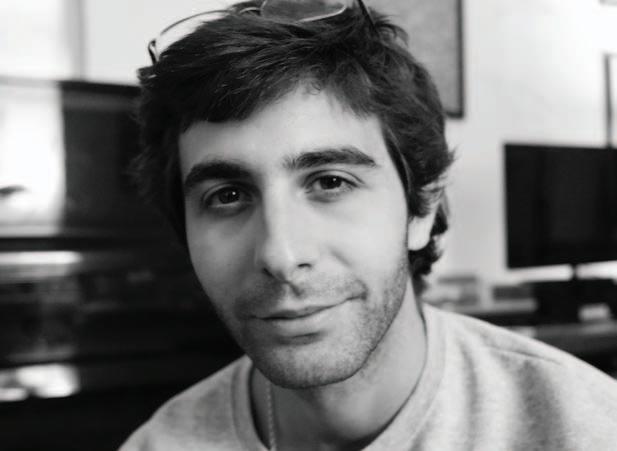
In 2019, Lunnie left her job as literary director at Playwrights Horizon, a nonprofit off-Broadway theatre, to freelance. Since then, she has collaborated more directly with a variety of individuals and institutions, she said.
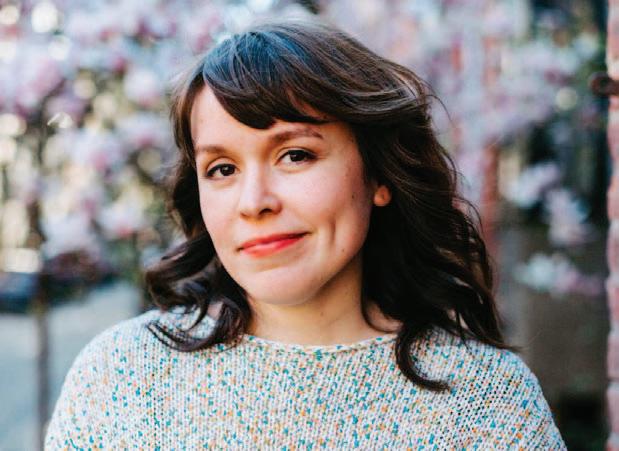
As a freelance dramaturg, Lunnie’s dayto-day also never looks the same. Some days, she sits in on a rehearsal with playwrights and works with them on the script. Other days, she meets with writers in the earlier stages and helps them develop their ideas.
for best lead actor in a musical, and the musical itself won best musical. He was finally able to pay off student loans and had validation for what the voice in his head had been telling him for so long, he said.
Last
down,
competition.
“I think I really loved performance and theatre and all of that and my brother loved theatre but also music, and it was just sort of a match made in heaven, or a match made by our mother,” Lazour said.
Pinkham’s parents also introduced him to theatre early on. Theatre was a natural solution that came out of a parent-teacher conference during which Pinkham’s teacher said they needed to find him an outlet for his “reckless creativity.” His parents were quick to enroll him in a kids theatre.
Lunnie, though, had a later start to the performing arts—theatre entered her world at BC. When she began her freshman year, she had never heard of the word dramaturg, and certainly never imagined it would become her career, she said.
Scott Cummings, a professor in BC’s theatre department, introduced this term to Lunnie, and he quickly became a mentor to her, helping her identify what became her career path, she said.
A career in theatre became a more palpable reality to all three alumni during their time at BC.

For Lazour, his early passion for writing shows with his brother continued into undergrad, even though his brother was in New York studying music at Columbia University, he said.
Lazour’s political science and theatre double major developed his love for political theatre, he said. He co-wrote the show The Grand Room with his brother, which premiered during his senior year at BC. The play tells the story of an affluent family living on Cape Cod during the Great Depression, offering commentary on the economic crisis among the upper class.
Though this was his first time producing a show on this level, Lazour was inspired by the strength and confidence of the theatre
rather than following the plot as the writers intended it to be acted. After he was unable to remember his lines, he put his head in his hands and squatted down on stage, completely breaking, which shifted his priorities on stage going forward, he said.
“I had done something selfish on stage,” Pinkham said. “I had made a particular moment about me, Bryce, getting a laugh from my friends rather than delivering on [the] playwright’s intention.”
ACT II: POST-GRAD LIFE
For all three alumni, the transition from BC theatre to trying to make it in the real world was heavily guided by the theatre department faculty. Cummings encouraged Lunnie to apply to intern at the Actors Theatre of Louisville during the summer before her senior year.
Another source of inspiration for Lunnie was English professor Elizabeth Graver, who was her thesis advisor.
“I really loved, not only the space to think about and sort of refine my own writing, and the generosity of her mentorship, and her sort of reader’s eye, but also building the muscle of engaging collaboratively with other people and their writing, [which] really turned into what I do,” Lunnie said.
Through her mentorship relationships with Cummings and Graver, Lunnie began to discover how theatre and writing could combine into a career.
After she graduated from BC, Lunnie returned to the Actors Theatre of Louisville to begin her career with a fellowship in the literary office. The fellowship was only supposed to last nine months, but Lunnie stayed in Louisville for five years.
The Actors Theatre of Louisville is known for its Humana Festival of New American Plays. Lunnie was tasked with
Lazour’s free time over the past years has been dominated by his most recent production, We Live in Cairo, which premiered at the American Repertory Theatre in Cambridge, Mass., in 2019, he said.
“I was in the International Relations of the Middle East class [at BC], and I saw a photograph of all these students above Tahrir Square in Cairo,” Lazour said. “They were all uploading testimonials and photos from the protests below. After I saw that photo, I talked to [my brother], and we started.”
Once inspired by an idea, Lazour and his brother play around with generating songs, dialogue, and characters for the play, which he said is the best part because there’s no pressure.
In this stage, the pair create the world for the show and contemplate potential themes.
“[We ask ourselves] what are the things that get us excited, [what are the things that] get us angry?” Lazour said. “What about society do we think needs improving?”
Similarly, for Pinkham, the struggles of acting’s unpredictable and volatile nature have been complemented by moments that assure him to stay in the industry. At age 30, he had officially gotten the role of a lifetime—originating the role of Monty Navarro in A Gentleman’s Guide to Love and Murder on Broadway.
After his initial audition and callback for the show, Pinkham was scheduled for a chemistry read with his co-star Jefferson Mays, who he had long looked up to. The day before the read, he was at his sister’s wedding in California. While on the plane to New York, he flipped to the first lines of the play that his character has—“October 19, 1909.”

“I hadn’t flipped to the first page before this … October 19 is my birthday,” Pinkham said. “When I saw that opening line … that’s when I knew I had it.”
In 2014, he received a Tony nomination
“I had finally proved it to myself,” Pinkham said. “It gave me a great deal of confidence because I knew I could lead a Broadway show and help win it a Tony award. It gave me license to trust myself, to know that I belong here with all of these people. The entire experience was monumental.”
COVID-19: CLOSING THE CURTAIN
All three BC alumni’s careers have had their share of freedom and unpredictability, which was only worsened by the COVID-19 pandemic. With Broadway shut down, the theatre industry has had to find other ways to support itself.

The daily tasks for many in the theatre industry have shifted, according to Lazour. His meetings with individuals potentially interested in his show have all become virtual and his days of writing in cafes are over, at least for now, he said.
Although We Live in Cairo closed before the start of the pandemic, Lazour and his brother wanted to find a way that fans could enjoy the music from the show from home. They released an album titled Flap My Wings with singer-songwriters and activists from all over the Arab world singing the songs from We Live in Cairo
“We were like what if we invite all of these activists, the songwriter activists who are integral to our show, like they were inspirations for the characters of our show, and their music was inspiration for the score
half an hour before curtain, she found out that the show had been canceled. Like most people, Lunnie did not realize how drastically her life was about to change, she said.
Despite the challenges of being a dramaturg in a time without live theatre, Lunnie has been able to find work. Before the pandemic, she worked on audio adaptations of shows that had productions in New York, leading to the opportunity of doing the audio for the theatre division of Audible—an audiobook streaming service.
She also produced audio adaptations of two plays—Good Grief by Ngozi Jane Anyanwu and Transfers by Lucy Thurber.
“That was really helpful, to be working on things in the belief that they will have a life when we can gather in person again,” Lunnie said.
Despite the challenges the pandemic poses to the entertainment industry, the silver lining for Pinkham is that he spends more time with his kids, he said. When he does have time to himself, ideas for future projects revive him in this stagnant time.
Pinkham is hopeful for the future of the profession, he said. The time away from the theatre—and the events that have occurred in between—has allowed the industry to begin cultivating a better version of the American theatre, he said.
He said he predicts that new situations that audiences have undergone in the past year will be brought to the forefront when theatre returns. This is especially possible through donations to charities from those
of the show,” Lazour said.
They emailed Hamed Sinno, a Lebanese-American vocalist and songwriter, and Ramy Essam, who was coined “the voice of the Egyptian Revolution.” The artists could interpret the songs however they wanted, and the Lazours produced the tracks and combined them to form the album.
“These artists are extremely busy, but because of the pandemic, everything shut down, so it’s like, ‘Why not collaborate on something like this?’” Lazour said. “It just ended up that everyone we asked said ‘yes’ to the project.”
The album was produced remotely, with everyone recording it in their homes, result-
who enjoy live performances, music, and art, including The Actor’s Fund, The Sable Project, and other organizations that support emerging Black artists across the country. Most of all, Pinkham is excited to be back, whether it is on the stage or in the audience, he said.
“With a family, I’ve considered choosing a working life that is more stable, but I don’t think that I’ll ever stop wanting to perform,” he said. “It’s my drug of choice; I just throw myself to the wolves of live performance and try and come up with something that will make people laugh or cry or somewhere in between, and that’s enough of a rush for me.”
THE HEIGHTS
in a global album with songs produced in Mexico, Paris, Cairo, California, and Boston.
March, at the beginning of the lock-
Lunnie was in Louisville working on a play in the Humana Festival. On March 12,
A8 MONDAY, APRIL 19, 2021
PHOTO COURTESY OF PATRICK LAZOUR
After his time at BC, Lazour became a playwright and writes shows with his brother.
PHOTO COURTESY OF BRYCE PINKHAM
PHOTO COURTESY OF SARAH LUNNIE
Lunnie found her passion for theatre at BC and now works as a dramaturg.
Pinkham was nominated for the Tony award for best lead actor in a musical.
Three alumni share their path into the theatre world and their transition to pandemic times.
By Emily Kraus Heights Staff
NewtonSERVES, a city-wide cleanup, is set to return this year in a limited capacity at various Newton locations after having been called off last year because of the pandemic.
“It’s been around a long time in the city and it [has grown] more and more every year, pre-COVID,” Paula Gannon, director of Newton Cultural Development, said. “COVID kind of put it to a halt, but it’s been growing so much before COVID.”
Each spring since it began in 2000, the event provides an opportunity for people to get outside and spruce up Newton in a spring cleaning effort after winter, according to Gannon.
“It’s an opportunity to get outdoors, to have this spring, you know, sort of fresh air and flowers starting to bloom and grass turning green,” Gannon said. “And it’s the time when the city needs to be spruced up and cleaned up from the winter and dead leaves and dead trees and debris, and it really takes a lot of hands to be able to clean a lot of the open spaces that we have in the city.”
The city-wide clean up will take place on May 2 from 9 a.m. to 4 p.m., according to Blair Lesser Sullivan, the executive director of Newton Community Pride. Some projects will occur in either morning or afternoon sessions, while others will take the entire day, she said.
Recalling past years, Gannon said that after cleaning up the locations the city is changed in a day. She said there isn’t enough staffing to manage all of the city’s public spaces and the day of service contributes to this effort to maintain the city.
“From the city’s perspective we are so reliant and so grateful to residents who want to come forward and support all of that effort,” Gannon said. “And the other side of the people who do it who love to be participated in a project like that, that has such a ‘wow’ end result where you can see after a few hours the impact you’ve had in your little space.”
This year, there are 32 sites for the day of service, with 200 volunteers signed up, as of Friday. The goal is for 500 to 600 people to sign up, Sullivan said. Some of these sites include schools, the old Newton burial grounds, and Crystal Lake, Sullivan said. In past years, there have been 60 to 70 sites
and over 1,000 volunteers, she said.
“Each site was looked at in terms of the space that the site has and what would be a safe number of volunteers to gather at that location, because every one is unique,” Sullivan said. “So each of those sites have its own specific number of volunteers that we’re allowing this year and once that is, once they’ve registered to that number then it’s closed and no more volunteers will be accepted.”
While NewtonSERVES is a Newton Community Pride event, Sullivan said that the organization partners with the city. NewtonSERVES registers volunteers and projects, and distributes t-shirts, while the city provides the supplies needed for the projects, according to Sullivan.
“It’s a lot of time and effort on the crew at the city, and we’re so grateful that we have the volunteers help us,” Gannon said. “So it’s a real partnership between the city, the residents, and Newton Community Pride, and it really is like a three legged stool.”
NewtonSERVES is one of many of Newton Community Pride’s efforts to beautify the city. Also this spring, the organization worked on Newton Al Fresco,

an initiative started to create decorated outdoor dining spaces.
“Our mission is tiered in that we do arts and culture service and beautification,” Sullivan said. “So, to do this event it covers, you know, doing community service for the city as well as beautifying the city, so that’s … a huge reason why we’re involved.”
In past years, the event has featured indoor cleanups, like painting lockers in schools, according to Gannon, but because of the pandemic, the event will take place entirely outdoors this year in order to abide by COVID-19 restrictions.
Volunteers will be required to follow physical distancing requirements and bring their own gardening supplies to avoid sharing materials. In the past, gardening supplies such as shovels have been provided by Newton.
“We’ve had a tremendous response from volunteers so far, who are anxious to get out and continue this work in a safe way [and]we’re really concerned about keeping it safe for everyone, for the volunteers, for us, and for the staff,” Sullivan said.
Interested volunteers can sign up for their desired site until April 21. The number of sign-up spots is limited and walk-ins will
not be allowed. All volunteers must register individually, as opposed to registering in a group, which was allowed in prior years, Gannon said.
Volunteers typically consist of residents of all ages, and entire families show up to work on a site together, Sullivan said.
“It really runs the gamut of ages, and abilities, and numbers,” Sullivan said. “It’s just open to anyone and everyone.”
With the long-awaited return of the event, volunteers from previous years are looking forward to helping again, Gannon said.
“People are really excited that this year we’re emerging with it again, even though it’s a smaller capacity event,” Gannon said. “They’re still so grateful to be able to do something.”
Although the event returns this year with modifications, NewtonSERVES will bring back the sense of community, as volunteers work together to improve their city.
“It’s the community feel too, just being with others, and having that, you know, camaraderie, a new end, you know,” Sullivan said. “In a typical year, you get to meet people, too. I mean, this year they will but they’ll just be six feet apart.”
4C Project Plants Trees to Honor COVID-19 Losses
trees and choosing their locations and species. Parks requested beech trees to be planted on campus.
The first planting will take place on Upper Campus by Tudor Rd. on Thursday at 4:30 p.m., which falls during BC’s Green Week. At this location, BC’s Landscape Planning and Services will plant three trees with the assistance of student volunteers.
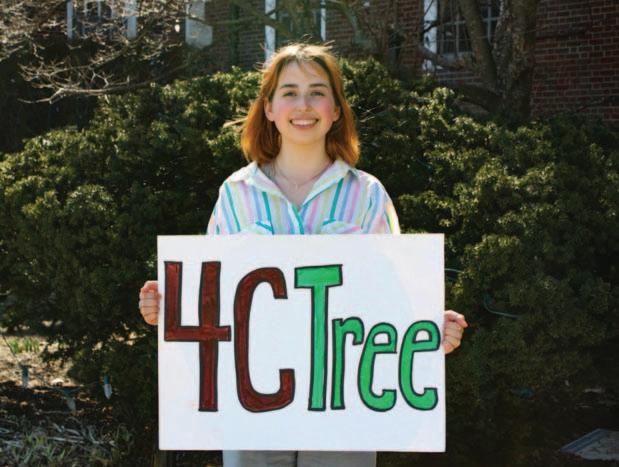
The Newton trees will be planted at Newton schools and parks through the city’s Department of Forestry beginning this month.
“I am really looking forward to that first planting. I think it’s going to be really special to finally see us break ground and finally come to fruition,” Parks said. “I’m excited to just see the whole project
Since beech trees are large, though, Bellavia said she needed to find locations with enough space for the trees to grow over time. Bellavia also had to find a local nursery that had these trees in a decent size, she said.
Bellavia also said she focused on choosing locations on the Newton side of BC’s campus with open space for the trees to grow.
Three trees will be planted on Upper Campus, and two trees will be planted on Newton Campus by the main entrance near Centre St., according to Bellavia.
Bellavia selected this location because many trees have died from disease there
we see all the time. I want something different.”
Bellavia selected a magnolia tree to replace a beech tree that was removed in front of St. Ignatius Church. She said she chose a magnolia tree because it would not grow to block the view of the church.
While some trees on campus are marked with plaques, Bellavia said that there will not be plaques placed with the 4C trees. Bellavia said BC Facilities has not installed plaques in recent years.
“It’s difficult because then if you have a construction project or the tree dies or it becomes a little complicated because then you have a plaque that is not associated with the tree anymore or has to be moved, so it’s a little difficult when you’re dealing with a living entity,” Bellavia said.
Following the first year or two after the planting, Bellavia said members of her staff will continue to water and nurture the trees. For the ceremony, she said that members of her staff will prepare the holes for the trees in advance so all three trees can be planted at the same time.
While coordinating a location for the planting during Green Week was stressful at first, Parks said that she feels confident now that she confirmed a time and place with Bellavia.
Parks also recruited eight student volunteers to assist in planting the trees on Thursday. She used the Class of 2024 GroupMe to gather volunteers, and received messages from students who were interested in being involved in the planting ceremony.
group primarily gathered donations through crowdsourcing.
Since the project began in October, Parks has attended weekly hour-and-a half -long meetings to discuss plans for the project, including events to raise money.
Parks said she sent out emails to alumni to gain support, and that she and members of Green Newton sent out letters to their friends, families, and neighbors to see if they could make a donation, no matter how small.
“One thing that we did was we had an event at a Chili’s where you got a discount on whatever you had and part of the proceeds were donated to the project, so that was really cool,” Parks said.
come together because I know how hard Elizabeth has worked on this and I’ve also worked hard on it.”
The group hopes to plant 170 trees this spring and continue planting in the fall in
order to reach a total of over 200 trees, Parks said. The group is also working on a virtual map so residents can easily locate the 4C trees.
One of the struggles during the early stages of the project was identifying space to plant all of these trees throughout Newton Parks said.
Involved in both communities Parks said she serves as the liaison between Green Newton and the University.
Parks approached BC Facilities in November to discuss t he possibility of planting trees on campus. This initiated Bellavia’s role in the project, she said.
“I’m so proud and impressed with all the students that have been involved in this, because, I mean, this has been such a horrific year across the board for everyone, and to have some recognition for local people that have, you know, succumb to the virus, and at least have some kind of memorial to commemorate their loved one I think is ver y significant,” Bellavia said. “And a nice collaborative effort between the city and BC.”
Bellavia coordinated purchasing the
in the past five to seven years.
“We’ve done some removals, and this was a good opportunity to replace what we lost,” Bellavia said.
Two beech trees, a dawn redwood, a
katsura tree, and a magnolia tree will be planted on campus, according to Bellavia.


“There are only a small number of katsura on our campus so I wanted to diversify the plant palette,” Bellavia said. “I didn’t want to pick maples and oaks and things that


Another difficulty of the project was the amount of money that the group needed to raise in order to make the planting possible, Parks said. Newtonians, though, have not been shy about showing their support.
This week, Parks and other members of Green Newton will be sitting outside of Newton City Hall handing out pamphlets with information about the project,
according to Parks. The group has also spread the word on its Instagram and Facebook pages
them should be in the ground, in about a week’s time, once we start,” Welch said.
Once the city has planted the trees, Welch said, they will receive weekly watering for at least one year from members of the city’s forestry staff.
He said that the majority of the trees will be oak, elm, American linden, crab apple, and cherry, with a few other tree species mixed in.
“Because many of the sites were open areas, school grounds not having any overhead wires or other obstructions, those types of sites lend themselves to larger growing trees, trees that will grow to be taller and larger,” Welch said. “So based on that we chose from a list of available tree species that the nursery purchased from has based on their availability, what we have, based on our experience with those wells, and the locations.”
to
4C has raised $36,158, which is more than to its $60,000 Pa P rks said that all of the will go towards purchasing the trees, which cost $150 each.
than halfway to its $60,000 goal. Parks said that all of the money will go towards
Parks sa id that the
She said that planning the project was challenging at times because they had to do so remotely.
“Communication is just difficult sometimes like because everything’s virtual, it’s sometimes hard to find times when everybody can talk and meet,” Parks said.
Welch, who is overseeing the tre e plantings in Newton, said that 170 trees will be planted at a number of school locations and at parks throughout Newton
“They had requested that, if it was possible, to really focus on school sites or park sites. And based on the number of trees they wanted to get planted, and in the short timeframe, we needed to pull off the project from when they first reached out to us, school sites and park locations were the easiest place to find homes for the trees,” Welch said Welch said that members of the city staff will be responsible for the majority of the planting , with some assistance from volunteers.
“I think it will take us about a week, maybe a little bit more or a little bit less … but generally, I would say the majority of
Since 1970, the number of trees in Newton’s public spaces has dwindled from 40,000 trees to 20,000, according to Green Newton. Welch said that there are a variety of reasons why the city has lost trees over the past 40 years.
a of reasons the has lost trees they city’s of
“The city has lost street trees because of decline and death. There’s been loss of trees on private property in the city,” Welch said. “So the way that these trees help that is that they help restore and add to the city’s tree canopy. Most of these trees aren’t going on the street, so they won’t address our loss of the tree population but they will certainly help address the loss of the overall tree canopy.”
Both meaningful COVID-19.
Both meaningful and practical, the trees will not only help Newton environmentally but also restore lost trees in the city. In accordance with the 4C message, the trees will provide an enduring memorial for those lost to COVID-19.
“I think they’re going to be a really spe-

cial memorial and show the community that we’re not going to forget about these people that have passed away, that we care about them and that we’re trying to make a difference in Newton,” Parks said. “And also just show that the environment is something else that we care about and how people can play a role in that, even ordinary people. Like, we’re just college students.”
“And also show that the environment is else that we care about and colleg
THE HEIGHTS
NewtonSERVES the Community With Day of Volunteering
A9 MONDAY, APRIL 19 , 2021
PHOTO COURTESY OF JOJO PARKS
Jojo Parks, CSON ’24, helped to plan and fundraise for the 4C Tree Project.
we
GRAPHIC BY OLIVA CHARBONNEAU / HEIGHTS EDITOR
ge
Tree Project, from A1
PHOTO COURTESY OF ELIZABETH SOCKWELL
Elizabeth Sockwell stands with members of Green Newton to promote the 4C Project.
By Josie McNeill Asst. Metro Editor
After over a year without live performances, the Huntington Theatre Company will be ushering in a new wave of theatre-lovers to Boston this season. The Huntington announced on Thursday that it will be open for in-person, indoor shows during the 2021-2022 season.
“It is with great joy and deep gratitude that The Huntington announces our 40th season,” said Huntington Managing Director Michael Maso in the announcement. “The reopening of our stages will be a powerfully emotional moment for our city, one that all of us at The Huntington are greatly looking forward to sharing with audiences in person this fall.”
The Huntington arranged a lineup of seven plays that will be performed beginning on Aug. 27, with the last performance of the season on June 26, 2022. The Huntington had committed to the playwrights, directors, and actors involved in all of these titles prior to the COVID-19 pandemic but was unable to follow through with production at that time due to the closing of the theaters in March 2020.
“We’re planning for indoor theater, and, of course, we will adjust and adapt if things change and the guidelines change, but our hope is that by the fall, we will be able to resume live, in-person performances,” Temple Gill, Director of Public Affairs and Strategic Partnerships of the Huntington, said in an interview with The Heights
The plays address a range of topics, from climate change in Hurricane Diane by Madeleine George to the setbacks women have faced in U.S. history in What the Constitution Means to Me by Heidi Schreck.
One of the plays, Common Ground Revisited , was adapted by Kirsten Greenidge and inspired by the Pulitzer Prize–winning novel Common Ground: A Turbulent Decade in the Lives of Three American Families by J. Anthony Lukas. The play centers around three diverse families in Boston in the ’60s and ’70s and their experiences with integration and court-mandated busing.
“How integrated or not integrated the Boston public school system is right now is a huge topic of conversation,” Gill said. “And I believe this play will just be really interesting and inspiring and will create a lot of opportunities for important conversations.”
Other productions in the lineup include Our Daughters, Like Pillars by Kirsten Greenidge, Witch by Jen Silverman, Teenage Dick by Mike Lew, and The Bluest Eye, adapted by Lydia R. Diamond based on the novel of the same name by Toni Morrison.
Our Daughters, Like Pillars was originally set to open the week before the Huntington went dark, according to Gill. This upcoming season will give these plays a new chance to come alive.
“Because we feel committed to those artists and those titles, and they’re all really wonderful projects, we’re so happy to make good on that commitment and have those productions come to fruition,” Gill said.
The productions will take place primarily at the Virginia Wimberly Theatre in the Calderwood Pavilion, with one production performed at the Emerson Cutler Majestic Theatre while the Huntington Theatre Company mainstage undergoes renovations. The majority of performances usually take place at the Huntington Avenue Theatre on Huntington Ave.
Recordings of the productions at the Virginia Wimberly Theatre will be available online for those who cannot attend in-person, according to Gill.
Gill said the decision to hold in person, indoor performances is based on trends in vaccine distribution and the continued decline of positive COVID-19 cases.
“Our hope is that everyone is getting vaccinated, but the numbers are looking good, and that people will be ready by the end of the summer to come back to the theater and be in the same space, and enjoy live performances once again,” Gill said. “We’re very hopeful about it.”
Because of its optimism about the positive progress of the pandemic, the Huntington does not anticipate that its actors will have to wear masks. Instead, the actors and stage crew will undergo rigorous testing to ensure everyone’s safety, according to Gill. The Huntington does anticipate mandating audience members to wear masks.
When the Huntington first closed its doors last March, organizing productions and working in person was impossible, according to Gill. It was difficult for the staff to adapt.
“It has just been a very weird time for us,” Gill said. “Everyone’s working from home. We have had layoffs and furloughs and salary reductions. It has been a challenging time.”
While they were not able to have live shows, the Huntington did host a series of audio plays called Dream Boston. For these plays, ranging from eight to 20 minutes long, the Huntington asked local playwrights to dream about their favorite places in Boston in the post-pandemic future.
“They run the gamut in topic and tone and are these really wonderful, efficient gems of audio plays,” Gill said.
The Huntington also partnered with GBH, a Boston public radio station, to record a full-length radio broadcast of Tiger Style! by Mike Lew—a play that the Huntington produced in 2016. This recording is available as a podcast online. While these virtual adaptations were successful during the Huntington’s dark period, nothing compares to the experience of viewing a production in person, Gill said.
“I love the excitement of seeing friends and colleagues in the lobb y before the show starts—you know that 10 minutes before curtain where there’s just a great energy in the room,” Gill said. “I think that first performance, when people are able to gather together and applaud at the end of the show, is going to be really powerful and exciting.”
Booksmith Opens a New Chapter With The Novel Kitchen
 By Olivia Vukelic Heights Staff
By Olivia Vukelic Heights Staff
Brookline Booksmith has served as an integral part of Coolidge Corner for over 60 years as an independent and family-owned bookstore. The bookstore has now expanded into the food industry with The Novel Kitchen, offering a place for customers to sit and grab a bite to eat with friends or a good book within its store.
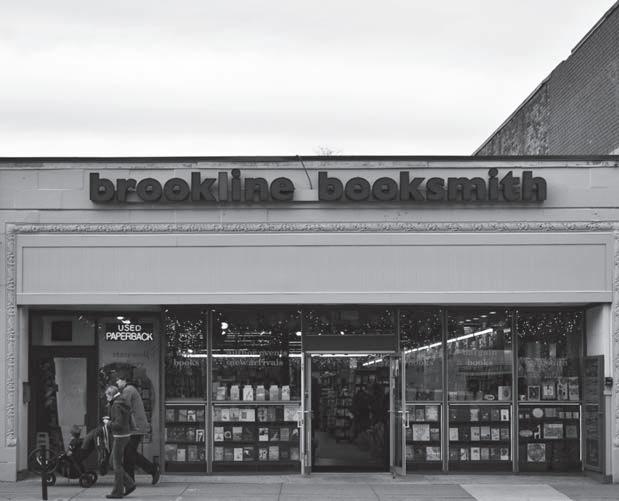
Booksmith’s mission is to “foster community through the written word, represent a diverse range of voices and histories, and inspire conservations that alter and enrich lives,” according to its website. In line with this mission is providing a place for customers to eat and converse.
“The store was approached by the town to consider a restaurant or bar within their establishment,” Julianne Webster, a consultant for The Novel
Kitchen, said. “They were encouraged by the Brookline community which was essential since the store is extremely community focused.”
Booksmith prides itself on its commitment to the community, including welcoming customers into the comfort of the store and partnering with book clubs, teachers, librarians, seniors, and local organizations such as BLUEBikes, the Boston Public Library, and the Brookline Arts Center, according to its website.
Brookline Booksmith signed a lease in February 2020 to expand into the neighboring building at 28 Harvard St., which used to be a Verizon store. Since then, the owners have renovated the space and adapted it into an eatery.
The vibrant space is filled with top-selling books, curated gift tables, houseware items, and lively puzzles and games. As customers wander
through, they’ll notice that tucked in the back, The Novel Kitchen sign hangs above a cold case along with an inspiring Julia Child quote.
While browsing for books, customers can fuel up on a selection of speciality cheeses, crackers, and beverages as well as sweet treats like cookies and chocolate. All of the food offered is pre-made and ready to eat.
“As their specialty food buyer, I essentially bring in all of these complementary, high-end, hard to find speciality grocery products,” Webster said. “We transformed the space so people now shop the area as part of an inclusive experience.”
The store works with a small number of distributors, including Provisions International Ltd. located in Vermont for various perishable goods, and Baldor to source locally made drinks, Webster said.
Webster said the original plan was for The Novel Kitchen to function as a cafe during the day and a bar at night. Within the bookstore, Webster said the space would provide sit-down meals to customers throughout the day and custom cocktails, wine, and charcuterie at night.
“We also intend to use the space for events as well,” Webster said. “Integrating the bookstore with the cafe and restaurant, we hope to host author tours and signings in the space, with customers not only attending for the event, but [also] the food and drinks.”
Once the new reality of the pandemic set in, however, the open restaurant and bar plans were set aside and a new concept emerged, Webster said. These original plans for the opening of The Novel Kitchen as a cafe and bar were adjusted to accommodate the needs and comfort of the community as a result of the pandemic, accord-
ing to Webster.
“When COVID hit, we had already taken over the new space for dining and needed to figure out how to make the space useful,” Webster said.
“Brookline Booksmith is so deeply rooted in tradition, and people find solace here, but many customers were unwilling to and fearful of wandering in the bookstore while others had their masks off eating.”
As Booksmith moves forward with implementing its original plan for the space, Webster said that elements from the current set up will be incorporated into the new space, combining the retail cookbook section with an
expanded dining area.
Webster said it is still unclea r whether the original concept will debut this September or be delayed until 2022. This depends on COVID-19 restrictions and the store’s abilit y to secure partnerships with loca l restaurants to bring in a wider foo d selection.
“If people haven’t been in since the renovation, we have constantly rotating themed displays and new produc t lines based on the cookbooks being promoted,” Webster said. “Wande r around the new space and get a sense of it with the prospect and possibility of more to come.”
Newton Recieves Grant To Rehabilitate Christina St. Bridge
By Rahul Harve
For The Heights
The City of Newton began a feasibility study to determine whether the Christina Street Rail Bridge will be renovated or rebuilt, Mayor Ruthanne Fuller announced on April 8.
“The project will provide an assessment of reuse or replacement of the Christina Street bridge for use as a fully accessible, shared-use bicycle and pedestrian connection between Newton and the Blue Heron Trail in the state Department of Conservation and Recreation (DCR) land in Needham,” Fuller said.
The bridge, which connects Newton and Needham, was in use from 1959 to 2010. Pedestrian access to the bridge closed two years ago due to compromised piers and deteriorating conditions, according to Fuller. Assistant Environmental Planner Claire
Rundelli said in an introductory video about the study that the current condition of the bridge was likely due to a combination of age, ice action, and logs and debris.
While the bridge was closed, the city applied for state grant money to renovate it, Fuller said. Newton received $56,700 from the MassTrails Program in August and is now taking the first steps toward reopening the bridge for pedestrians, including conducting a feasibility study, according to Fuller .
“The city is matching with just over $14,000 of the grant agreement, and that project includes the feasibility study of the bridge, feasibility assessment of developing those cost-options, and the development of conceptual design plans,” Rundelli said.
Rundelli hopes that further grants or state funding will become available
for future project work.
“The feasibility study is just about determining what options are the best for getting the bridge open for folks,” Rundelli said. “We do have a timeline from the grant that is funding the feasibility study, so the work is due to be completed by the end of June.”
As part of the study, the city is asking residents to fill out a survey about their usage of the bridge and the function that they would like the renovated bridge to serve.
“The feasibility study is just about determining what options are the best for getting the bridge open for folks,” Rundelli said. “We do have a timeline from the grant that is funding the feasibility study, so the work is due to be completed by the end of June.”
Consulting and design firm VHB is in charge of conducting the feasibility study and assessment, and will build up the concepts once the study is
completed. Rundelli said that after the feasibility study is completed, community engagement will open up and conceptual designs will be presented if there is time at the end of the process.
Rundelli said the three options include renovation, reuse, or demolition and replacement.
The final choice will come down to the City of Newton and the town of Needham based on functionality, cost, and access.
“We want whatever we open to the public to have as long of a lifespan as possible,” Rundelli said. “If we’re only going to get another 20 years out of the bridge if we rehab it, then maybe the best option is to build a new bridge.”
Fuller said that the new bridge will help to connect the Newton side of Needham St. and the Needham area east of I-95.
“The feasibility study will lay the
foundation for the construction of a fully accessible, shared-use path connection, when funding is available,” Fuller said.
After structural and geometric assessments have been conducted, designs for rehabilitation, demolition, reconstruction, or construction will be developed, Fuller said.
She said that concept level plans will then be developed for the preferred scenario.
Rundelli said that the feasibilit y study will lay the groundwork for a new bridge that pedestrians, commuters, and bikers can share when walking between DCR land in Needham and Upper Falls in Newton.
“The hope with the feasibilit y study is that we will be able to have a full analysis of the options so that we can really see the big picture and make the best choice for the community o f the future,” Rundelli said.
THE HEIGHTS
Huntington To Hold In-Person Performances This Fall
A10 MONDAY, APRIL 19, 2021
OLIVIA VUKELIC / HEIGHTS STAFF
The Novel Kitchen offers speciality cheeses, crackers, beverages, and more.
OLIVIA VUKELIC / HEIGHTS STAFF
Brookline Booksmith has been located in Coolidge Corner for over 60 years.
Paul McCartney Reimagines ‘McCartney III’











Paul McCartney’s new album, McCartney III Imagined, features remixes and covers of his songs from McCartney III, which was released in 2020. Overall, on McCartney III Imagined there seems to be a greater focus on the music and instrumentation rather than the vocals in the songs. There is also an emphasis on combining different musical styles and sounds throughout the album.

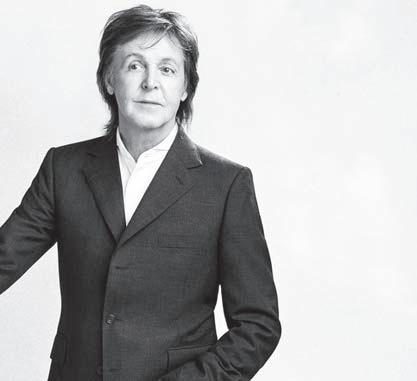
The album opens with “Find My Way” (feat. Beck). This song has a very upbeat, electronic kind of sound. It explores both the lower register and falsetto that make McCartney’s voice distinct, showing off his impressive vocal range and control that has
remained even as he grows older. Dominic Fike’s cover of “The Kiss of Venus” has an alternative-rock sound with clear rock influences. In particular, a Beatles-esque sound is present in this song, especially in the guitar as it strums in a bouncy, electric rhythm. There is a heavier focus on vocals in this song compared to others on the album.
But, contrasting this focus on vocals is “Pretty Boys” (feat. Khruangbin). This song has a simple yet funky baseline. “Pretty Boys” has a very summery kind of sound, with less of a focus on vocals and more of an emphasis on experimentation with the instrumentation.
The St. Vincent remix of “Women and Wives” has a jazz-influenced sound. The backing vocals create the effect of an



MUSIC
entire chorus singing in the background, with harmonies and echoes reminiscent of a gospel choir. The next remix, “Deep Down” by Blood Orange, has a very chill, experimental sound. There are few lyrics in this song—it is mostly instrumental with brief interjections of words.


“Seize the Day” (feat. Phoebe Bridgers) is one of the most beautiful songs on the album. It has a very similar sound to Bridgers’ own music—slow and somber—and the harmonies of her voice add dynamic layers of sound to the song. The sound of this song takes influences from alternative rock, pop, and indie music, and its light and airy feeling is contrasted with the powerful guitar.

“Slidin’ ” features an intense rock sound with really cool guitar. Its rock sound is similar to that of Josh Homme’s “Lavatory Lil” on the album. Due to its heavy rock sound, “Lavatory Lil” is likely to remind the listener of The Beatles and The Rolling Stones.
Damon Albarn’s remix of “Long Tailed Winter Bird” serves as a kind of interlude on the album, as it primarily features slow instrumentals and repetitive lyrics before segueing into “Lavatory Lil.”
The Anderson .Paak remix of “When Winter Comes” has a very upbeat sound. There is a feeling of positivity and a resounding vibe of optimism that comes from the music. This sense is emphasized in the lyrics, when McCartney sings, “When summеr’s gone, we’ll fly away / And find the sun when
winter comes.” There is beauty in the sense that the narrator of the song will try to find warmth and joy with their beloved, even when the world is dark with winter.
The final song on the album, 3D RDN’s remix of “Deep Deep Feeling,” clocks out at nearly 12 minutes. It has a very experimental sound, with vocal effects and an electronic musical influence. This song speaks to the pain of feeling deep emotions for someone.
Instrumentation is very important throughout the album. Unique and interesting guitar lines are a prominent part of many of the songs, and the vocals on some songs seem to be there just to complement the masterful music of the tracks. This is not to diminish the importance of the vocals that are there, however, as the lyrics and the artists who lend their voices to these songs are key parts of the unique sound of the album.
McCartney III Imagined showcases many different artists and their different musical styles while still paying homage to McCartney’s musical genius. This album proves that his music is still relevant, and can be remixed in ways that give it new life. McCartney III Imagined takes risks in combining many different musical styles, but they form a cohesive look at the fluid nature of music. McCartney is by no means obsolete. This album proves that major artists of the past can come together with major artists of the future to create art of the present.
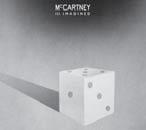
Manga Series Presents Amplified Humor
BY ALICIA KANG Assoc. Arts Editor
For the past few years, Netflix has been expanding its reach in terms of the genres it offers. From American classics to Korean dramas to Bollywood films, the franchise has broadened its international appeal. With this expansion comes the gradual globalization of viewers’ tastes. Now that Asian media is advertised and produced by Netflix, more and more American audiences are being nudged to consider shows outside of their routine, laugh track–heavy sitcoms.
Enter The Way of the Househusband, an anime produced by none other than Netflix itself, based on a widely popular manga created by Kousuke Oono in 2018. The story centers on Tatsu (Kenjirô Tsuda), a retired yakuza (“gangster”) boss previously nicknamed the Immortal Dragon who settles down after marrying. Before marriage, his days were spent intimidating citizens and fighting off members of rival gangs. But now, the Immortal Dragon spends his days packing adorable lunch boxes for his wife Miku (Shikuza Itô), and the only knife skills he shows off are in the kitchen.

The unique premise leads to a lot of hilarious moments and misunderstandings in Tatsu’s life, such as when the police crash a clandestine gathering Tatsu attends—suspecting his involvement in a drug deal—only to find him celebrating a birthday and bringing his homegrown basil as a party favor.
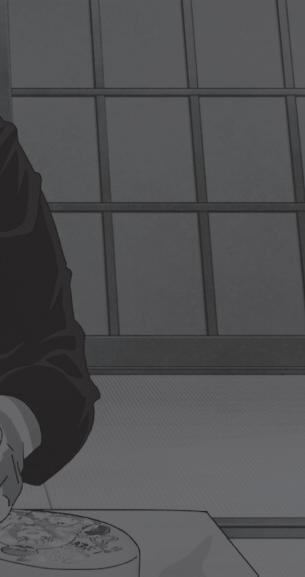


Those unfamiliar with Japanese anime might be surprised at the heavily episodic style of the series. Each episode contains a handful of short stories detailing extracts from Tatsu’s new life, lasting only a few minutes within longer 15-minute episodes. These snippets are often unrelated to each other, though they all follow the general outline of a day-in-the-life structure. The first episode, for example, jumps around from Tatsu’s encounter with a shady door-to-door knife salesman to his run in with an old gang member on the street to his attempts to throw a birthday party for his wife.





The show actually doesn’t stray far from the original manga it’s designed after, both in artistic style and in editing. Unlike other anime and animation in general, The Way of the Househusband doesn’t attempt to delineate smooth movements and seamless transitions between scenes. Instead, its editing style is blatantly and proudly comical. Most clips are extremely brief, lasting only a few seconds before cutting to the next image. The art within each frame is relatively still, with only a few small movements like a hand motion to indicate a character’s actions.
The show spurs an interesting conversation related to Japanese—and even American—gender roles. It’s still rare to see men quitting their jobs when they get married and settle down. Traditionally, married couples on TV and in animes consist of working husbands and domestic stayat-home wives. But, Tatsu not only defies
this stereotype, but he also seems entirely unaware this social norm even exists in his world. He seems blissfully unaware of how strange his life path is, and he takes pride in the dishes and little knick-knacks he makes while at home, including a hamburger steak and a wooden chair designed like a teddy bear. These eccentric scenes help the show break further out of the mold of traditional gender roles for married men.
To enhance the show’s zany energy, The Way of the Househusband applies the same sensational, frenzied music to Tatsu’s preparations in the kitchen as it does to his encounters with former fellow gang members on the street. While this effect obviously aims for humor, it also subverts expectations
for the typically quiet, boring depictions of domestic life. It turns the lives of stay-athome dads into hilarious, exciting dramas.
Though the show’s general concepts and themes may be quite progressive at times, watching the show provides little more than a laugh at its ludicrous hijinks. Perhaps the most enjoyable aspect of The Way of the Househusband is that it doesn’t pretend to be anything it isn’t.
It’s a straightforward comedy that any audience will enjoy as long as they’re up for a ridiculous laugh. And if viewers can jibe with the exaggerated animation and enhanced sound effects, they’ll find The Way of the Househusband to be a creatively comical adventure.
AJ Tracey has been taking his unique sound from West London to the world since his 2019 self-titled album. Even with the global success of his synthheavy harmonies on tracks like “Ladbroke Grove,” which was released on the album, and his 2016 single “Thiago Silva,” Tracey proves that his sound has developed. His slightly jazz-inspired single “Little More Love,” released on Thursday, is a departure from the sound of his past hits. Complementary to his lyrical agility, the melody of this song flows smoothly, and he opts to trade the synthy beats that are traditionally found on his songs for the saxophone solo that closes out his latest single. On “Little More Love,” the final single released before the debut of his latest album Flu Game, which was released on Friday, Tracey gets sentimental about his personal career growth.
Clarifying the significance of his name, Tracey raps, “My name’s Ché, the revolution leader from west / So I leveled up and got Guevara inked on my chest.”
Tracey also shows a little more love to American rapper DMX, who died on April 9, in the accompanying music video for “Little More Love,” which is reminiscent of a scene from the 1998 film Belly that starred DMX and fellow American rapper Nas.
Greta Van Fleet Sheds Led Zeppelin Sound
 BY CHARLEY CONROY Heights Staff
BY CHARLEY CONROY Heights Staff
From its conception, the Michigan-based rock band Greta Van Fleet has been struggling to shake the fact that it sounds a lot like Led Zeppelin. But it was never just that lead singer Josh Kiszka sounds almost exactly like lead singer Robert Plant of Led Zeppelin. The entire band seems to have been inspired by that Zeppelin sound in a way that was difficult to ignore in its 2017 EP From the Fires and debut album Anthem Of The Peaceful Army
But Greta Van Fleet saw a major improvement in developing a unique sound on its sophomore album The Battle at the Garden’s Gate. While The Battle at Garden’s Gate, released on Friday, is not some magic shift away from blues rock, it has become harder to claim Greta Van Fleet
is stealing from one band.
The Battle at Garden’s Gate is at its best when Josh Kiszka’s vocals and Jake Kiszka’s guitar shine on their own. At times, Jake lays down some incredible riffs that carry entire songs. The punchy and energetic riff for “Stardust Chords” is probably the best part, but Josh’s vocals hit a high point as he nears the heavenly “woah” at the end of each chorus.
The second half of the nearly nine-minute rock ballad “The Weight of Dreams” is notably better than its first half because Jake is given four minutes to go wild with an epic and powerful guitar solo. As the song closes out the album, it may go on a little too long like the rest of the song, but the young guitarist is arguably the best part of the band and he impresses when given the opportunity.

Lyrically Greta Van Fleet has not evolved too much since its first two album
releases, and it leaves a bit to be desired. “Light My Love” is a generic rock love song on the album, and the remaining songs aren’t replaced with anything truly spectacular. The opening verse for “Age of Machine” feels like it’s setting up some spectacular space odyssey or a critique on how the internet has taken over our lives as a long interlude of eerie yet airy guitars opens the song. But the song’s lyrics fail to amount to much meaning with only two unique verses that string together scattered ideas about internet culture, as Josh sings, “plugged in since the womb” and “unplug from the source.”
“The Barbarians” focuses on how violence consumes society, even from a young age, as Josh sings about “children with their toys of war.” But rather than lyrically diving deeper into this systemic issue, Josh spends a lot of the song’s runtime singing “woah.” There’s a lot of wasted lyrical potential like this throughout the album, and it’s disappointing to see Josh avoid saying anything substantial with his powerful vocals.
Something that shouldn’t go unaddressed is the length of the album and the span of each individual track. While each track spans about five minutes, the album moves at a fairly brisk pace. The only time you wish that a song would end a little quicker is once again on “The Weight of Dreams,” which might be a minute too long.

The reason the album doesn’t feel so monstrously long is that a lot of time is allocated for Jake’s guitar performance. Josh’s vocals even fade out at several points


throughout the album such as on the second half of “The Weight of Dreams” and on Jake’s guitar solo on “My Way, Soon.” The time spent giving Jake room to breathe makes the album feel bigger and even a bit epic. But the length of the album also masks the lyric problem. It’s difficult to complain about Josh’s sparse and underdeveloped lyrics when they’re intercut with one of the better young guitarists in music right now.
Josh’s lyricism is really one of the only things holding this album back. These are five-minute songs with two verses and a chorus or two. The one thing that would help Greta Van Fleet’s future albums is a concept or story to better tie the tracks together. The lyrical exposition presented in “Age of Machine” could have made for an epic space ballad or a critique of consumerism, but once again, the lyrics fall short of creating deeper meaning and insight.
In general, fans of Greta Van Fleet will have a fantastic time listening to The Battle at Garden’s Gate, while its critics probably won’t be as enthused. Greta Van Fleet has been a band wearing its influences on its sleeve from day one.
Even though this new album definitely doesn’t feel like a Led Zeppelin rip-off, Greta Van Fleet is probably going to have trouble shaking such claims. This is still a blues rock album and comparisons are going to be made to the greats that came before them. But, the band has made it much harder to find those influences, as Greta Van Fleet starts to find their own sound.
YEARS & YEARS
Years & Years’ new music video for its single “Starstruck” shows the true star quality of singer Olly Alexander. Years & Years used to be a trio consisting of Mikey Goldsworthy, Emre Türkmen, and Alexander, but in March the pop group split and became a solo project led by singer Alexander. This single is the first piece of music Alexander has released since the band’s split, and it is a clear indicator that he’s not going anywhere.
In the music video for “Starstruck,” Alexander plays two twin roles (think Lindsay Lohan circa 1998 in The Parent Trap), with one twin obsessed with chasing after the other. To start, Alexander stares in the mirror at his reflection—but his image comes to life only for the chase between the two to begin. The music video shows Alexander, dressed in silk cloud-patterned button down pajamas and a navy robe, constantly running from his clone, a high energy, animated caricature of the lead singer.
It’s a fun and engaging concept, and it shows how Alexander is self-aware of his own silliness. It’s also fitting for the video to only have Alexander in it considering Years & Years is now entirely his project. The video truly highlights his ability to keep an audience hooked on him and his performance. Closing out the video, Alexander delivers a funny and goofy performance, as he shifts into a solo dance routine where he’s seen performing the robot in conjunction with ballet dance moves.
In terms of the actual technical element of doubling Alexander, it’s definitely not the most impressive example of this technique. There’s no interaction between the two characters and rarely are they put in the same shot together. This, however, gives Alexander an opportunity to show off his ability to create distinct characters between himself and the alternative Alexander.

In Years & Years’ new music video Alexander proves that he can keep the fun synth-pop hits coming and his fans engaged by delivering a high energy performance.

THE HEIGHTS
PHOTO COURTESY OF CAPITOL RECORDS
DISTRIBUTED BY CAPITOL RECORDS RELEASE APRIL 16, 2021 OUR RATING
‘MCCARTNEY
III IMAGINED’ PAUL MCCARTNEY
PHOTO COURTESY OF NETFLIX
‘THE WAY OF THE HOUSEHUSBAND’ CHIAKI KON DISTRIBUTED BY NETFLIX RELEASE APRIL 8, 2021 OUR RATING
PHOTO COURTESY OF REPUBLIC RECORDS ‘THE BATTLE AT GARDEN’S GATE’ GRETA VAN FLEET DISTRIBUTED BY REPUBLIC RECORDS RELEASE APRIL 16, 2021 OUR RATING MUSIC
TELEVISION
MONDAY, APRIL 19, 2021 ‘STARSTRUCK’
TONIE CHASE
‘LITTLE
MORE LOVE’ AJ TRACEY
A11 BY ERIN PENDER Heights Staff
LILY TELEGDY
SINGLE REVIEW
MUSIC VIDEO
G RACE M AYER Arts Editor
A series of spring traditions have been entirely canceled or undergone extreme reinvention since the COVID-19 pandemic. Marathon Monday and Spring Break were erased from calendars. The ALC Showdown has transformed into a showcase event and shifted from the bustling stands of Conte Forum to an outdoor v iewing event, with screens scattered throughout campus for students to socially distance themselves on the grassy quads.
But, the annual Boston College Arts Festival—an event open to all BC students, alumni, and neighboring Boston communities—is returning to BC’s campus as a hybrid of in-person, v irtual, and pre-recorded events after converting to an entirely digital format in the wake of the pandemic last year.



“We made it happen even in a really weird form in late April last year when literally everything was insane,” Arts Fest production manager Allison Lardner, Lynch ’21, said about pulling together the entirely virtual Arts Fest last year. “Why can’t we make it happen again a year from then?”
Lardner, who is responsible for organizing the event and ensuring COVID-19 protocols are followed when the festival begins, said the Arts Fest team, comprised of 12 full-time Boston College Arts Council student members and Arts Fest director Tatiana Flis, has been making preparations for the event since August. This year, the Arts Council had to start entirely from scratch when converting the festival to its hybrid format.
From Thursday, April 29 to Saturday, May 1, a slew of events featuring 28 arts groups will occur on BC’s campus, and videos will be uploaded on the Arts Council’s newly designed Arts Fest website and promoted on its social media pages. Adapted to abide by social distancing requirements, the in-person portion of the festival will partly take place under a tent on Stokes Lawn and on a large performance stage on O’Neill Plaza. A new Arts Walk, spanning across locations on campus from Robsham Theater, Maloney Hall, Devlin Hall, and Carney Hall, will also showcase artwork.
For performances that take place in person, unique v irtual content will be made available online at the time the performances are being performed live. A livestreamed poetry performance of Spoon River Anthology by Edgar Lee Masters w ill also be accessible from the Arts Fest website.
Videos and livestreams will also be made available on the Arts Fest website as arts groups perform in-person.
The festival’s theme, “A New Wave of Creativity,” is reflected in the range of art pieces and



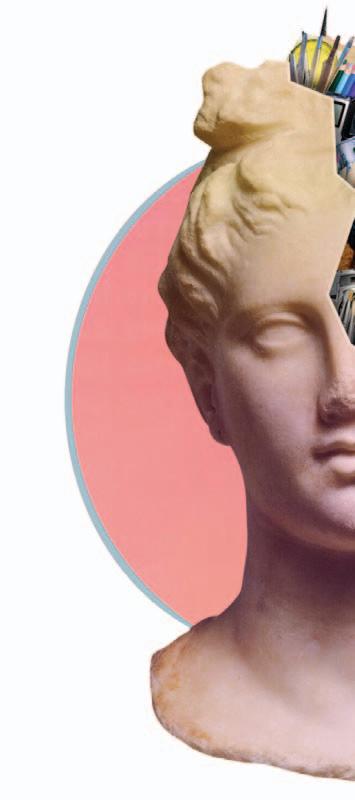
performances as well as the hybrid formats Arts Fest is utilizing in order to pull off the three-day event.
Although Arts Fest is packed with group singing, dancing, and theatre performances, the Arts Fest team has also focused on highlighting individual student, alumni, staff, and faculty artists on campus through Instagram story takeovers and a podcast series that features student artists on BC’s campus.
“We definitely need this community-building, bonding activity,” Yifan Wang, the visual arts director for Arts Fest and MCAS ’22, said. “And I really see Arts Fest as this bonding event that will bring everyone together across campus, across departments, and from different cultural backgrounds.”
This year, Wang had the idea to start a podcast series featuring interviews with the artists whose work will be featured along the Arts Walk. Alongside the artwork displays, festivalgoers will be able to scan QR codes to listen to the artists speak about the inspiration behind their work and how they created their art pieces.
t pi eces.

































said the pandemic isn’t an overt theme students’ submissions have focused on, during the interviews she’s conducted with student artists, she discovered that many of them turned to art during the pandemic as a form of self-expression and introspection.
A lthough Wang a i d th e p an d emic s n’t o v ert he m e stue n ts ’ s ubmissio n s a v e f ou sed u ri ng h e ine r vi e w s he s onduc td w it h tude nt r tists, i scovered h at o f he m tu rn ed o art durin g h e pa nde mc as a f o rm o f elf-exp ression n d intros pe ction.
a way for them to escape or to just cope
“[Art] is probab ly wa y for them to s cape j ust
the tough situation that everyone was experiencing last year and this year too,” Wang said.
Wang has also been in charge of accruing artwork submissions for the Arts Walk and its larger virtual gallery available on the Arts Fest website, which will be curated by studio art assistant professor Hartmut Austen along with volunteer student ambassadors. The walk will also feature an interactive scavenger hunt component.
In addition to paintings, drawings, photography, pottery, and sculptures, Wang said the Arts Walk is also planning to incorporate literary works from students and the magazine groups on campus, including Kaleidoscope Stylus , and The Laughing Me-

h at ever y one y ear an d t h is n ub missions i ts l arger on th e h will b e s istant usten ud ent k wi ll a ctive n ent. n tings, pottery, sai d t h e n ning o r k s f rom a zine K al ei d osco p e , g hing M ek wi ll r

Arts Fest.
Battle of the Bands and the Singer Songwriter competition—two precursor events for students to earn a spot competing at the BC’s Best competition—will also take place over the span of the three-day festival. Nine BC students will compete on the O’Neill Plaza outdoor stage in the Singer Songwriter competition, where they will perform their original songs and showcase their vocal talents. For Battle of the Bands, six BC student bands will perform in three acts.
Winners of both competitions will move on to perform at BC’s Best. In the past, these three events have been hosted several weeks before Arts Fest, but now they will occur back to back.

These daily Instagram stories show viewers a behindthe-scenes look at how Arts Fest is made and bring attention to artistic processes, ranging from learning choreography at dance practices to glimpses o f how artwork is created by students in BC’s art


During the three-day festival, Arts Fest organizers will take over Arts Council’s Instagram stories for the day, giving students who are attending virtually a chance to see what the event is like in person.
“People, especially first years and even sophomores who still don’t quite know what BC is, will be just excited, I think, to have that kind o f spirit of togetherness and creativity,” Lardner said.
Usually, members outside of BC’s student community also participate in Arts Fest, as faculty and staff often bring their kids to campus during the festival. But this year, they’ll have to participate virtually. Arts Fest’s hybrid format will enable all attendees, on and off campus, to participate in the festival.

Arts Fest marketing coordinator and website designer Eleni Krupinski, MCAS ’21, said in the past Arts Fest has never needed its own website platform. But in order to make the festival easily accessible to all audiences and to showcase BC arts groups that can’t feasibly perform due to social distancing and space restrictions, the website will serve as a hub for the festival and, once the event closes, as an archive that will be accessible beyond the three-day event.
azines will be set out along the walk for students to
Although the event is usually known for its spontaneity—students freely milling in and out of looming white tents that dot the lawns outside of Stokes Hall and O’Neill Library— festivalgoers will have to register for free tickets to attend in-person events for the sake of contact tracing and limiting the number of people inside the tents. For those who can’t attend in person, there will be videos and a virtual gallery on the Arts Fest website.
Inside the Stokes tent, Full Swing, Boston College Dance Ensemble, Synergy, and the Golden Eagles Dance Team will perform live in-person choreographed dances. While the number of performers on stage will be limited, video backdrops of pre-recorded dance routines will be displayed behind the dancers.
BC Underground, previously discontinued at the 2018 Arts Fest, will return this year on May 1 as an open-mic showcase that will give any student an opportunity to perform at
Annabel Hodson-Walker, CSOM ’21, undertook transferring Arts Fest to its virtual format last year within the span of a month—when it typically takes nearly the whole school year to plan for the in-person event. Since Hodson-Walker was the only person responsible for the Arts Council’s social media pages last year, she took it upon herself to shift the in-person event to an online format by contacting the arts groups who were originally planning on participating in Arts Fest for digital content. The Arts Fest team then conducted a virtual Arts Fest by promoting the content it acquired on the Arts Council’s Instagram, Facebook, and YouTube pages as well as on a landing page for the Arts Festival that was created on the BC website.
“Especially at a time that was so low for many people, I thought it was really important to still have arts be a part of everyone’s lives,” Hodson-Walker said about organizing the virtual festival last year.
This year, Hodson-Walker, the current Arts Fest marketing coordinator, said the Arts Council has
“Everyone who is involved in the arts, they really love what they do,” Krupinski said. “And we want to continue to give people the space to do the things that make them happy. … We don’t want to have an environment where it’s just school. We want to keep creating the spaces where people can pursue their passions.”
While members of the BC BIGS program usually take a field trip to BC’s campus to see live events, Wang said the littles will get to participate in arts and crafts from home with an Arts Fest toolkit, which contains coloring activities.
Arts Fest has undergone a major transformation this year. After over a year of the COVID-19 pandemic in which a festival seemed far from feasible, Arts Fest demonstrates artists’ abilities to reinvent how people engage with art.
“It felt important to me [for Arts Fest] to really embody that belief that … art is a living thing,” Lardner said. “It is a thing that can transform with the times and can be a tool for transformation itself.”
invited students to take over its Instagram stories for a day throughout the school year.
A12 THE HEIGHTS MONDAY, APRIL 19, 2021
GRAPHICS BY OLIVIA CHARBONNEAU / HEIGHTS EDITOR IMAGES COURTESY OF BOSTON COLLEGE ARTS COUNCIL ter, Ma l one y Ha ll , Dev l in Ha ll C arne y Hall, will also showcase ork. o r p erformances that p lace in p erson, uni q ue al content b e made a ble the p erformance bein g pe re d ream ed ry peran ce o f n River o l og y E d g ar cc esfr om w eb site o s a nd d livems ad e av ai la l bl e on rts g roups r son h e e, e ativit y,” is reflected e ran g e w grab. A lthou gh known for its freel y millin g white tent s th of Stokes Hall festival g oer for free ti c so n ev ents and p eo p le in s w ho can’t w ill be vid Ar t I nside Swin g, Bo s se mb le, Syn E agles Danc c W hile the nu m stage will be li of pre-recorde display ed
w ill
op en-mic
Ar ts Fes t Battl Ba n ds S inger w r i ter c ti on —t t cursor e stude nt a sp o t B est c t ion t a ke p th e s th e t h f esti
Arts Council’s annual Arts Fest has been transformed into a digital and in-person format and will feature a capella, dance, poetry readings, theatre, and more.
beh BC Unde
return th
sho op
v s w i ll on th P la z a stage S inger So comp etitio th e y wi ll p t heir ori g in a a nd talents B t he Bands, bands will p erform in th Winners of both comp eti t move on to p erform at BC’s the pa st, these three events h A b ut now th ey will occur back A nnabel Hodson-Walke r ’21, undertook transferrin g A toitsvirtualformatlastyea o po d cast series f eaturing n terviews wit h t h e w h ose w ork Wa lk . A l ongsi d e t h e artwor k d i sl ay s, festiva lg oers wi ll b e abl e to c an Q R co d es to l isten to the r tists s p eak about the ins pia tion b e h in d t h eir wo rk nd how create d their r
du sa St ud ents’ wo rk b e d is pl ay e d on po st e b oards, and mag-
az
in es w ill s et o ut e walk for students to it alon g th gr ab
invite d stu d ents to ta ke over i ts I nstagr am stories for a d ay th roug h out scho ol y ear. T h es e d ai l y Instas tos h o w vi e w ers a beh in dthe- scenes l oo k a t h ow Ar ts i s m ade a nd b ring atte ntio n a r tist ic f rom l earnin g dance p ractices g l impses of h ow artwor k creat ed b y stu d ents in BC’s ar t stu d io s. During t h e t h ree- d ay f estiva l , Arts Fest organiz -





















































 By Olivia Vukelic Heights Staff
By Olivia Vukelic Heights Staff











 BY CHARLEY CONROY Heights Staff
BY CHARLEY CONROY Heights Staff
















